Although there are 68 species of eagles worldwide, each one of them is remarkable in its own right. From the tiny to the bold to the iconic, these incredible birds more than earn their place at the top of the food chain. Read on to explore the various types of eagles and discover their most distinctive characteristics.
*The types of eagles are listed in alphabetical order by scientific name.
1. Spanish Imperial Eagle (Aquila adalberti)
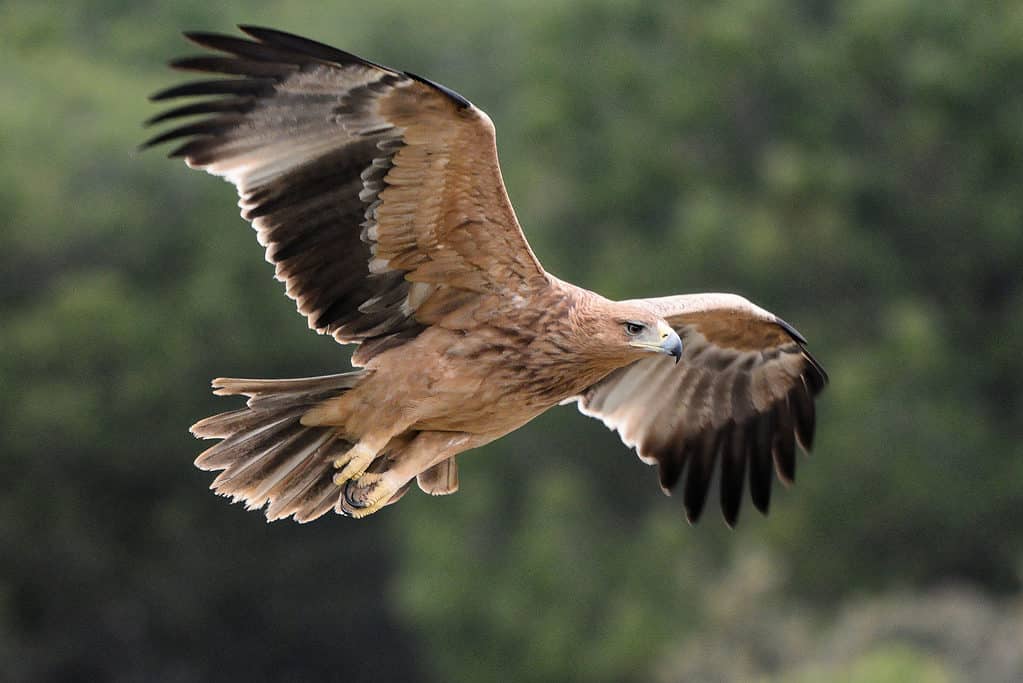
Spanish imperial eagles have a massive wingspan of up to seven feet.
©LABETAA Andre/Shutterstock.com
As is typical of eagles from the genus Aquila, the Spanish imperial eagle’s size is impressive. However, it tends to be shy of humans and highly territorial. It feeds mainly on rabbits but also pursues other mammals and birds. Alternate names for the species include the Iberian imperial eagle, the Spanish eagle, and Adalbert’s eagle.
- Genus: Aquila
- Color: Brownish-black from throat to belly; white marks on shoulders and wings
- Length: 28-33 inches
- Wingspan: 5.8 to 7.2 feet
- Location: Europe, Africa
- Habitat: Forests, scrublands, grasslands, savannas, wetlands, deserts
- Conservation Status: Vulnerable
2. Cassin’s Hawk-Eagle (Aquila africana)
This type of eagle is the smallest member of the genus Aquila. As with most birds of prey, the females are larger than males. The species typically hunts tree squirrels and birds. As part of the Aquilinae (booted eagle) subfamily, it sports feathered legs.
- Genus: Aquila
- Color: Dark brown with white spots and white chest/belly
- Length: 19.7 to 24 inches
- Wingspan: 3.4 to 3.7 feet
- Location: Africa
- Habitat: Forests
- Conservation Status: Least Concern
3. Wedge-Tailed Eagle (Aquila audax)
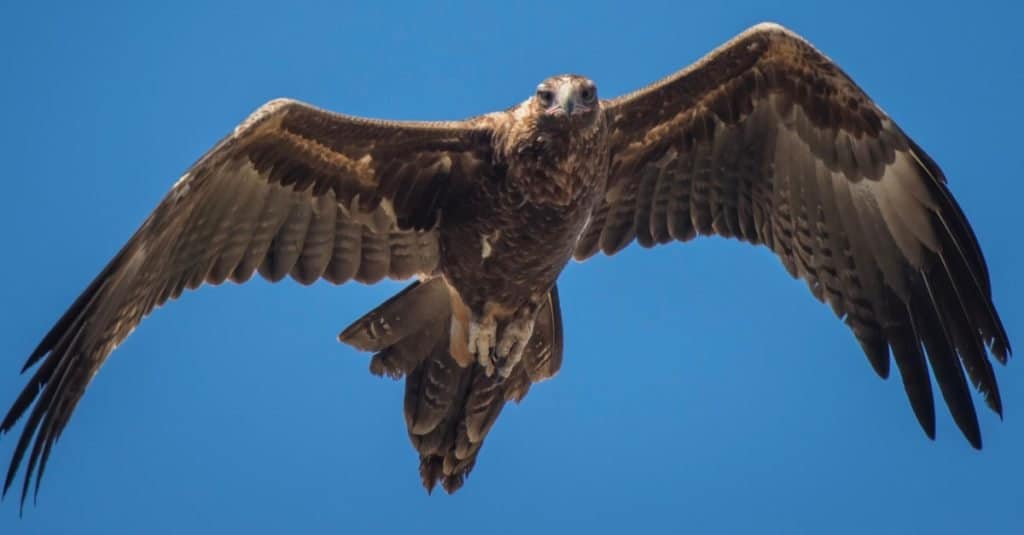
Wedge-tailed eagles are highly aerial and soar for hours on end.
©Terry Dell/Shutterstock.com
This type of eagle is notable for its wedge-shaped tail, its lanky form, and its rank as the largest bird of prey in Australia. These massive birds prey on other birds as well as small mammals. They often soar for long periods of time at heights of up to 5,900 feet.
- Genus: Aquila
- Color: Black or dark brown
- Length: 32-41 inches
- Wingspan: 6 to 9.3 feet
- Location: Australia, Indonesia, Papua New Guinea
- Habitat: Forest, savanna, shrubland, grassland
- Conservation Status: Least Concern
4. Golden Eagle (Aquila chrysaetos)

Golden eagles are the most widely distributed of all eagles.
©Al Carrera/Shutterstock.com
This species is the most widely distributed of all eagles and is one of the most distinctive. A golden eagle’s home territory can cover a distance of up to 77 square miles. Within these territories, they build large nests on cliffs or other high locations. They hunt a variety of prey including small mammals like rabbits and other birds.
- Genus: Aquila
- Color: Dark brown, golden-brown nape plumage
- Length: 26-40 inches
- Wingspan: 5.5 to 7.7 feet
- Location: Africa, Asia, Europe, North America, South America
- Habitat: Forest, shrubland, grassland, rocky areas, desert
- Conservation Status: Least Concern
5. Bonelli’s Eagle (Aquila fasciata)
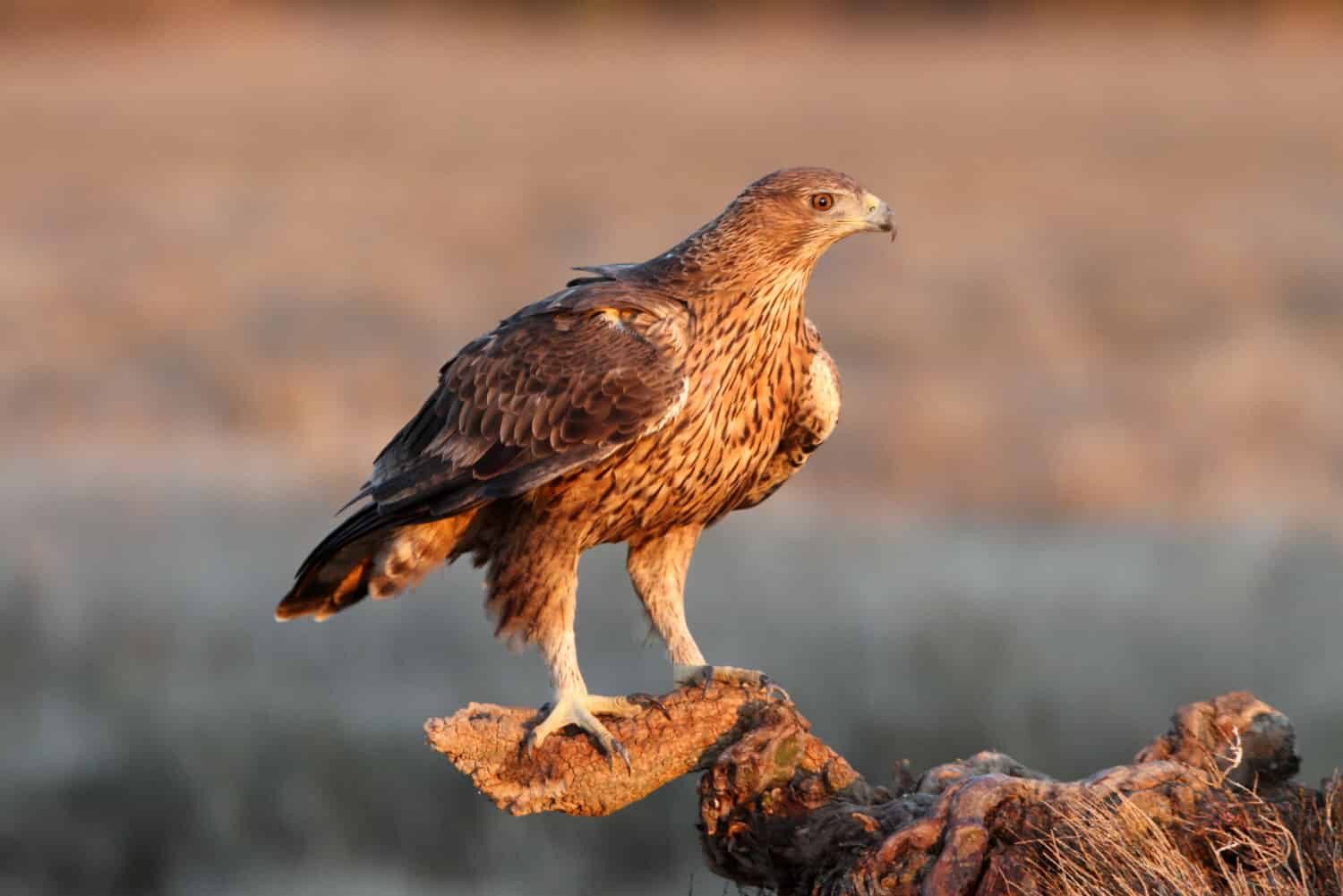
Bonelli’s eagle possesses the feathered legs of the booted eagle subfamily.
©Jesus Giraldo Gutierrez/Shutterstock.com
This bold species is known for being a particular predator of rabbits, galliforms, and pigeons, though it readily expands its prey base when necessary. It frequently soars and circles within its home range. As a member of the booted eagle subfamily Aquilinae, it possesses feathered legs.
- Genus: Aquila
- Color: Dark brown (dark chocolate or umber) above; cream underside with blackish-brown streaks; pale wing margins
- Length: 22-29 inches
- Wingspan: 4.7 to 5.9 feet
- Location: Africa, Asia, Europe
- Habitat: Forest, shrubland, grassland, wetlands, rocky areas
- Conservation Status: Least Concern
6. Gurney’s Eagle (Aquila gurneyi)
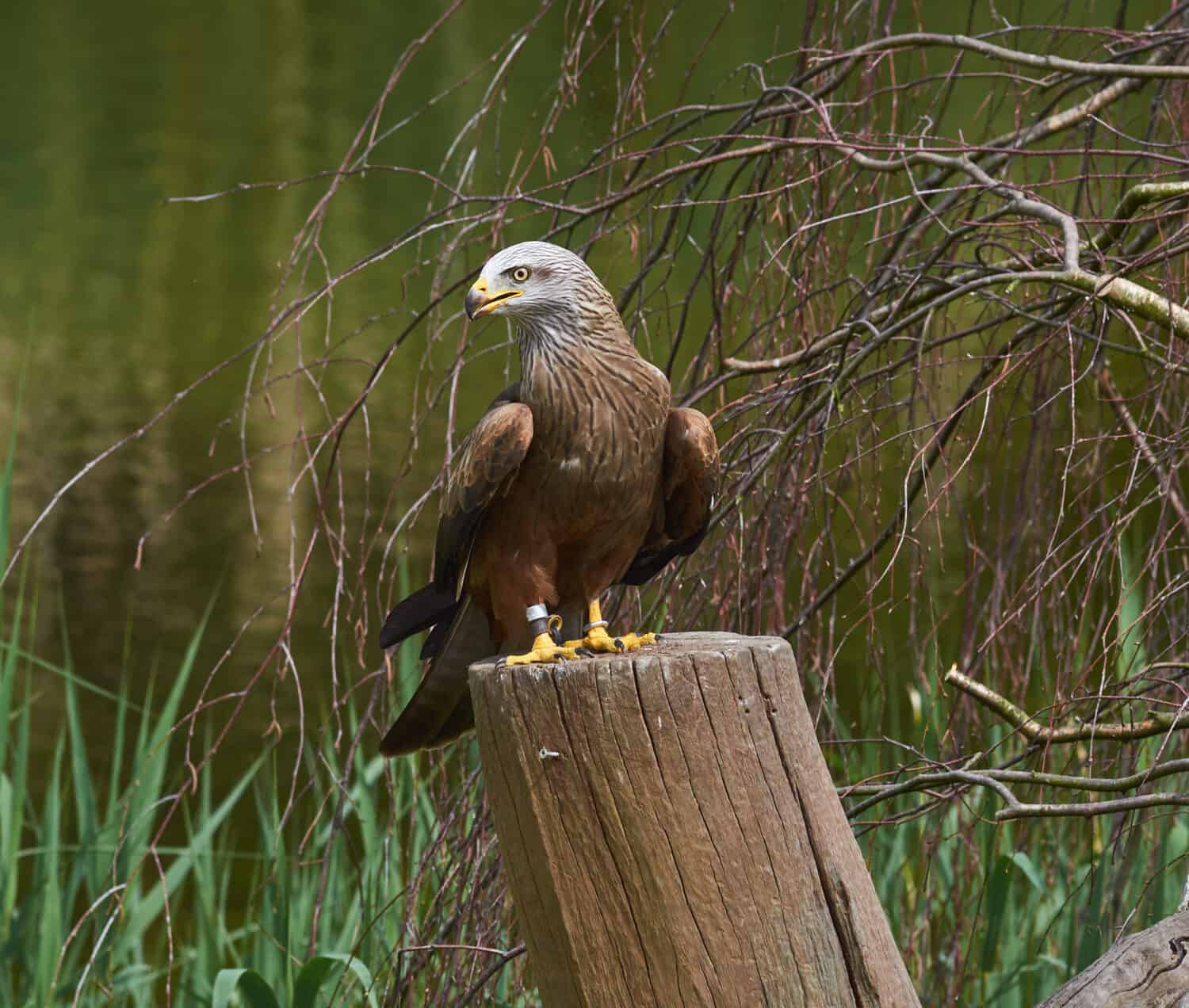
Gurney’s eagle flies at heights of up to 3,280 feet.
©tatianaput/Shutterstock.com
This species flies at heights of up to 3,280 feet, holding its wings level while gliding. Its diet consists of small mammals, birds, fish, and reptiles. Unfortunately, its populations are gradually declining due to habitat loss and degradation.
- Genus: Aquila
- Color: Black or dark brown; pale undersides
- Length: 29-34 inches
- Wingspan: 5.4 to 6.2 feet
- Location: Asia (Indonesia), Oceania (Papua New Guinea)
- Habitat: Forest
- Conservation Status: Near Threatened
7. Eastern Imperial Eagle (Aquila heliaca)
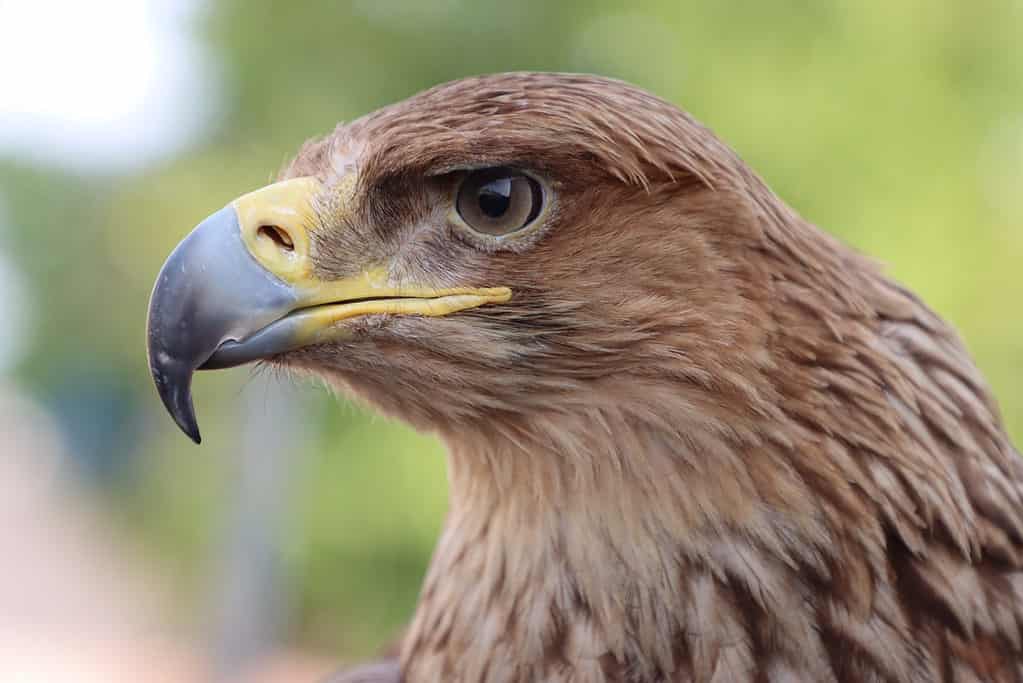
The eastern imperial eagle is notable for its large head and bill.
©Jrs Jahangeer/Shutterstock.com
Although this type of eagle is large, it is only average-sized for the sizeable Aquila genus. These eagles tend to be bolder and less shy around humans than other members of their genus. They are notable for their unusually projected necks as well as their large heads and bills.
- Genus: Aquila
- Color: Blackish-brown; cream or golden around crown and neck; white shoulder markings
- Length: 27-35 inches
- Wingspan: 5.8 to 7.2 feet
- Location: Africa, Asia, Europe
- Habitat: Forest, shrubland, grassland, wetland
- Conservation Status: Vulnerable
8. Steppe Eagle (Aquila nipalensis)
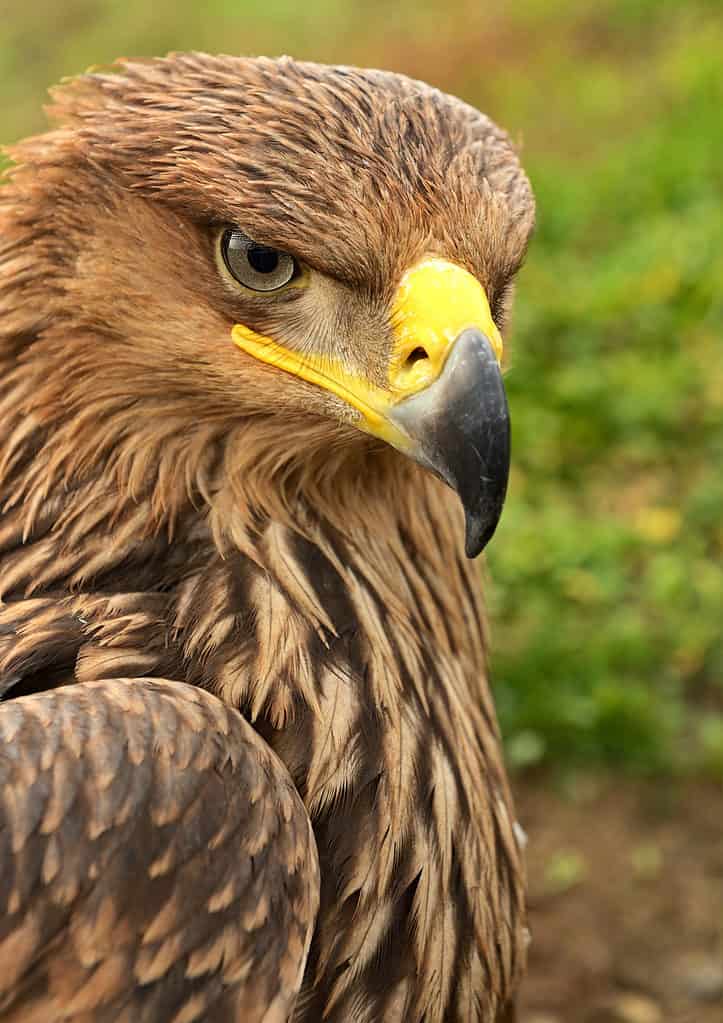
The steppe eagle typically breeds on steppes.
©iStock.com/Kyslynskyy
These eagles are named for their typical breeding habitat, the steppe. Wingspans for the species vary considerably with a potential difference of over three feet. Physically, it is a strong, almost bulky bird. It is occasionally mistaken for other species like the spotted eagle.
- Genus: Aquila
- Color: Dark brown
- Length: 24-35 inches
- Wingspan: 5.4 to 8.6 feet
- Location: Africa, Asia, Europe
- Habitat: Forest, savanna, grassland, rocky areas, desert
- Conservation Status: Endangered
9. Tawny Eagle (Aquila rapax)
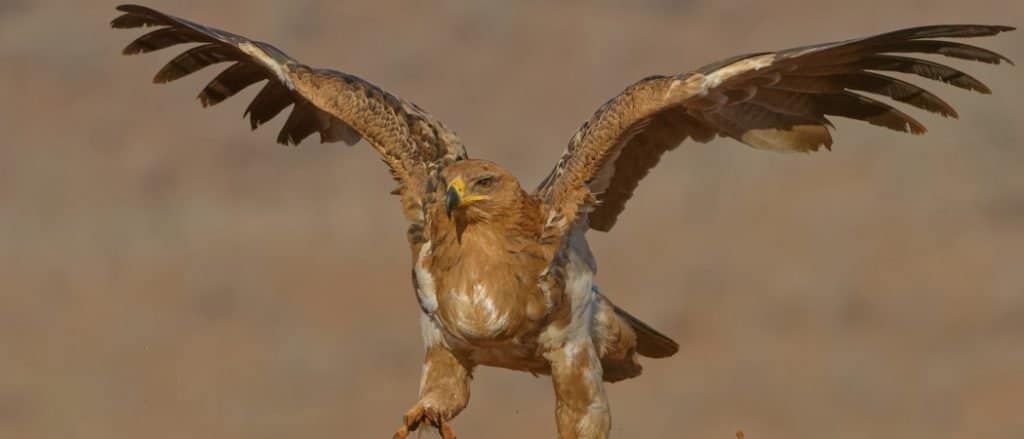
The tawny eagle possesses a striking aquiline silhouette.
©Tobie Oosthuizen/Shutterstock.com
This type of eagle tends to be smaller than most other species in its genus, though it is still fairly large compared to species from other genera. It is notable for its striking aquiline silhouette and scruffy appearance. Additionally, it is a frequent scavenger that enjoys feeding on carrion, roadkill, and trash.
- Genus: Aquila
- Color: Dark brown, greyish-brown, whitish or creamy dull rufous
- Length: 23-30 inches
- Wingspan: 5.2 to 6.2 feet
- Location: Africa, Asia
- Habitat: Forest, savanna, scrubland, grassland
- Conservation Status: Vulnerable
10. African Hawk-Eagle (Aquila spilogaster)
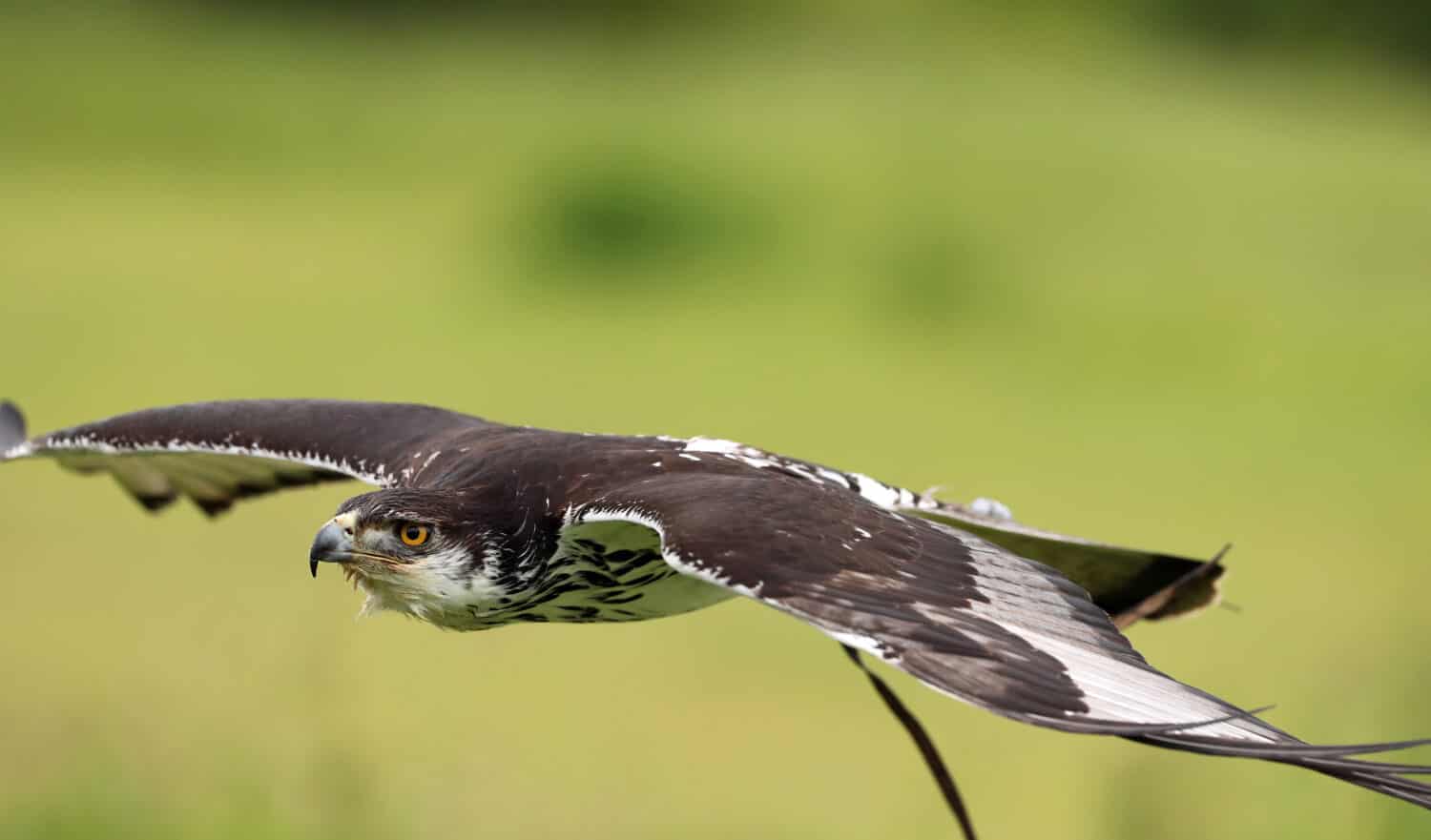
The African hawk-eagle is a powerful predator that hunts mammals, birds, reptiles, and other animals.
©scooperdigital/Shutterstock.com
This powerful, large-footed species primarily hunts small mammals and birds, though it also preys on reptiles and other animals. It builds stick nests of up to 3.3 feet across in large trees. For most of the day, it remains obscured within the cover of trees and foliage.
- Genus: Aquila
- Color: Black-grey above; whitish below
- Length: 22-29 inches
- Wingspan: 4.3 to 5.3 feet
- Location: Africa
- Habitat: Forest, savanna, scrubland, grassland
- Conservation Status: Least Concern
11. Verreaux’s Hawk-Eagle (Aquila verreauxii)
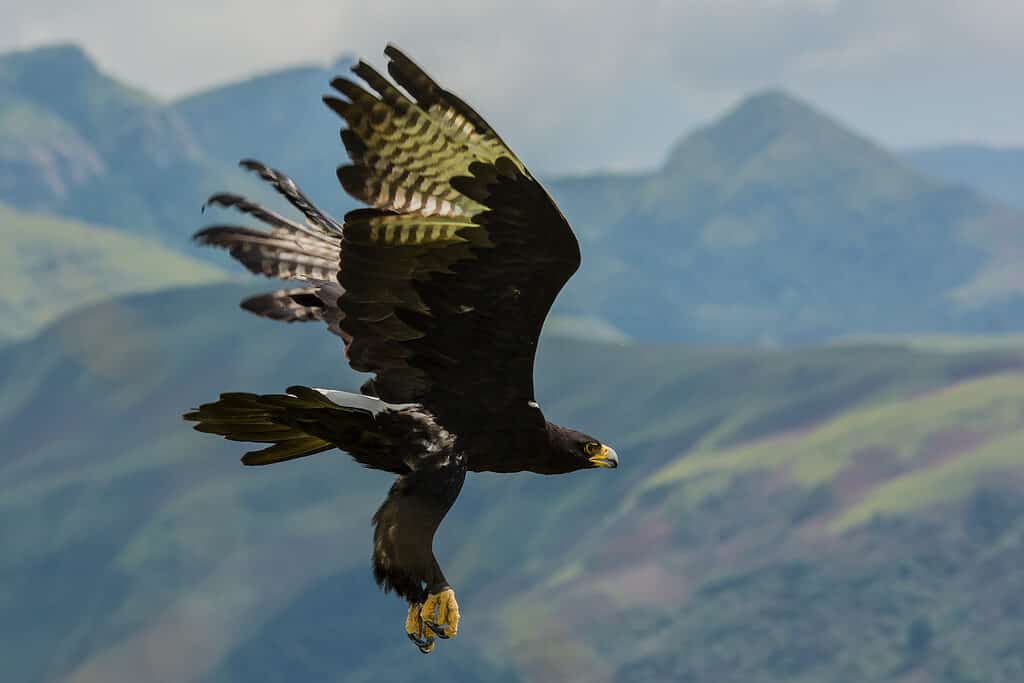
Verreaux’s hawk-eagle is the sixth-longest eagle in the world.
©Eleanor Esterhuizen/Shutterstock.com
With a body length of 30-38 inches, this species is the sixth-longest eagle in the world. Both its large size and its striking black-and-white markings set it apart from otherwise similar species.
- Genus: Aquila
- Color: Jet-black with white markings
- Length: 30-38 inches
- Wingspan: 5.9 to 7.6 feet
- Location: Africa
- Habitat: Savanna, shrubland, grassland, rocky areas, desert
- Conservation Status: Least Concern
12. Crowned Solitary Eagle (Buteogallus coronatus)

The crowned solitary eagle gets its name from the “crown” of grey feathers on its head.
©Pablo Rodriguez Merkel/Shutterstock.com
This species is also known as the Chaco eagle or the crowned eagle. Its name derives from the dark grey crest of feathers on its head. Its powerful, shrill call is audible from over a mile away.
- Genus: Buteogallus
- Color: Silvery-grey
- Length: 29-31 inches
- Wingspan: 5.6 to 6 feet
- Location: South America (Argentina, Bolivia, Brazil, Paraguay)
- Habitat: Forest, savanna, scrubland, grassland
- Conservation Status: Endangered
13. Black Solitary Eagle (Buteogallus solitarius)
Relatively little is known about this type of eagle, including its preferred prey. However, it is possible that it preys on a range of animals including snakes and deer fawns. It resides in mountainous or hilly forests and is occasionally confused with lowland species. Alternate names for this species include the solitary eagle and montane solitary eagle.
- Genus: Buteogallus
- Color: Dark grey to black; white markings on tail
- Length: 25-31 inches
- Wingspan: 5 to 6.2 feet
- Location: North America, South America
- Habitat: Forest
- Conservation Status: Endangered
14. Beaudouin’s Snake Eagle (Circaetus beaudouini)

Beaudouin’s snake eagle is a “sit and wait” predator.
©Upamanyoo Das/Shutterstock.com
This species prefers to perch on objects like dead trees or telephone poles to wait for its prey rather than circle from above. Although scientists have not thoroughly studied it, they believe its population to be declining.
- Genus: Circaetus
- Color: Greyish-brown above; white underparts
- Length: 24-26 inches
- Wingspan: 5 to 5.6 feet
- Location: Africa
- Habitat: Forest, savanna, shrubland, grassland
- Conservation Status: Vulnerable
15. Western Banded Snake Eagle (Circaetus cinerascens)
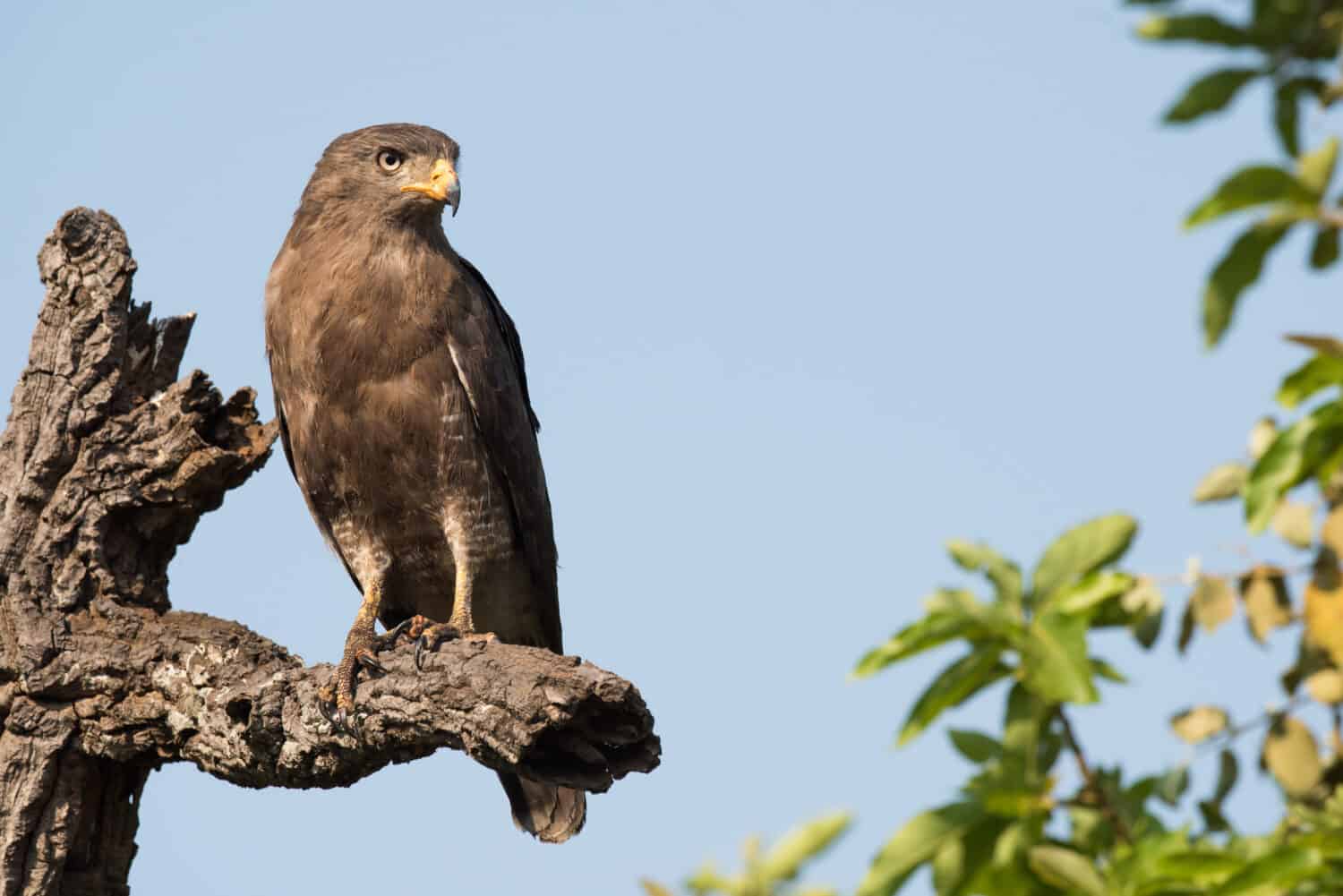
The western banded snake eagle tends to be solitary and elusive.
©Dave Montreuil/Shutterstock.com
This type of eagle is solitary and tends to remain hidden from sight. It preys mainly on snakes, though it will also eat other small vertebrates. Although it often inhabits woodlands, it avoids overly dense forests.
- Genus: Circaetus
- Color: Grey-brown
- Length: 24 inches
- Wingspan: 3.7 feet
- Location: Africa
- Habitat: Forest, savanna, shrubland, wetlands
- Conservation Status: Least Concern
16. Brown Snake Eagle (Circaetus cinereus)
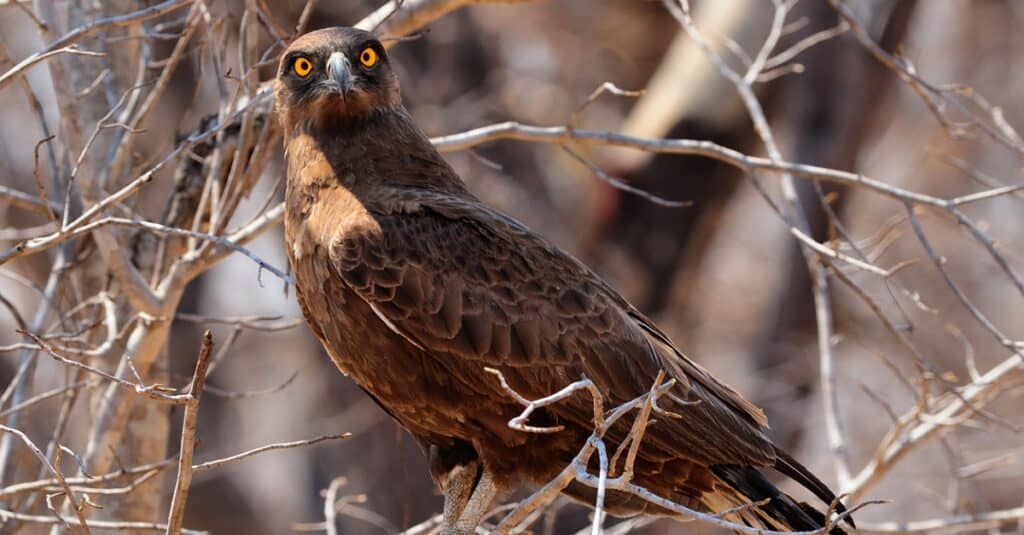
The brown snake eagle is capable of hunting large, venomous snakes.
©iStock.com/Shumba138
This species is a standard dark brown in color, though some insist it has a purple sheen in certain lights. Because it possesses a more powerful body than most snake eagles, it is capable of hunting fairly large snakes. It does not appear to shy away from targeting venomous snakes.
- Genus: Circaetus
- Color: Dark brown
- Length: 26-31 inches
- Wingspan: 5.3 to 6.6 feet
- Location: Africa
- Habitat: Forest, savanna, shrubland, grassland, desert
- Conservation Status: Least Concern
17. Southern Banded Snake Eagle (Circaetus fasciolatus)

The southern banded snake eagle is secretive except for its distinctive cry.
©Jeffrey B. Banke/Shutterstock.com
This type of eagle tends to be difficult to find except with the aid of its loud, high-pitched cry. Like other snake eagles, it primarily hunts snakes. Alternate names for this species include the East African snake-eagle and fasciated snake-eagle.
- Genus: Circaetus
- Color: Blackish-brown; grey-brown head; white underparts
- Length: 22-24 inches
- Wingspan: 3.9 to 4.2 feet
- Location: Africa
- Habitat: Forest
- Conservation Status: Near Threatened
18. Short-Toed Snake Eagle (Circaetus gallicus)

The short-toed snake eagle primarily hunts and eats snakes and lizards.
©COULANGES/Shutterstock.com
This species is notable for being among the largest of the snake eagles. It also spends more time in the air than most members of its genus, soaring with flattened wings. Its prey consists mostly of snakes and lizards.
- Genus: Circaetus
- Color: Greyish-brown above; whitish, blotched undersides
- Length: 23-28 inches
- Wingspan: 5.3 to 6.4 feet
- Location: Africa, Asia, Europe
- Habitat: Forest, savanna, shrubland, grassland, wetlands, rocky areas, desert
- Conservation Status: Least Concern
19. Black-Chested Snake Eagle (Circaetus pectoralis)
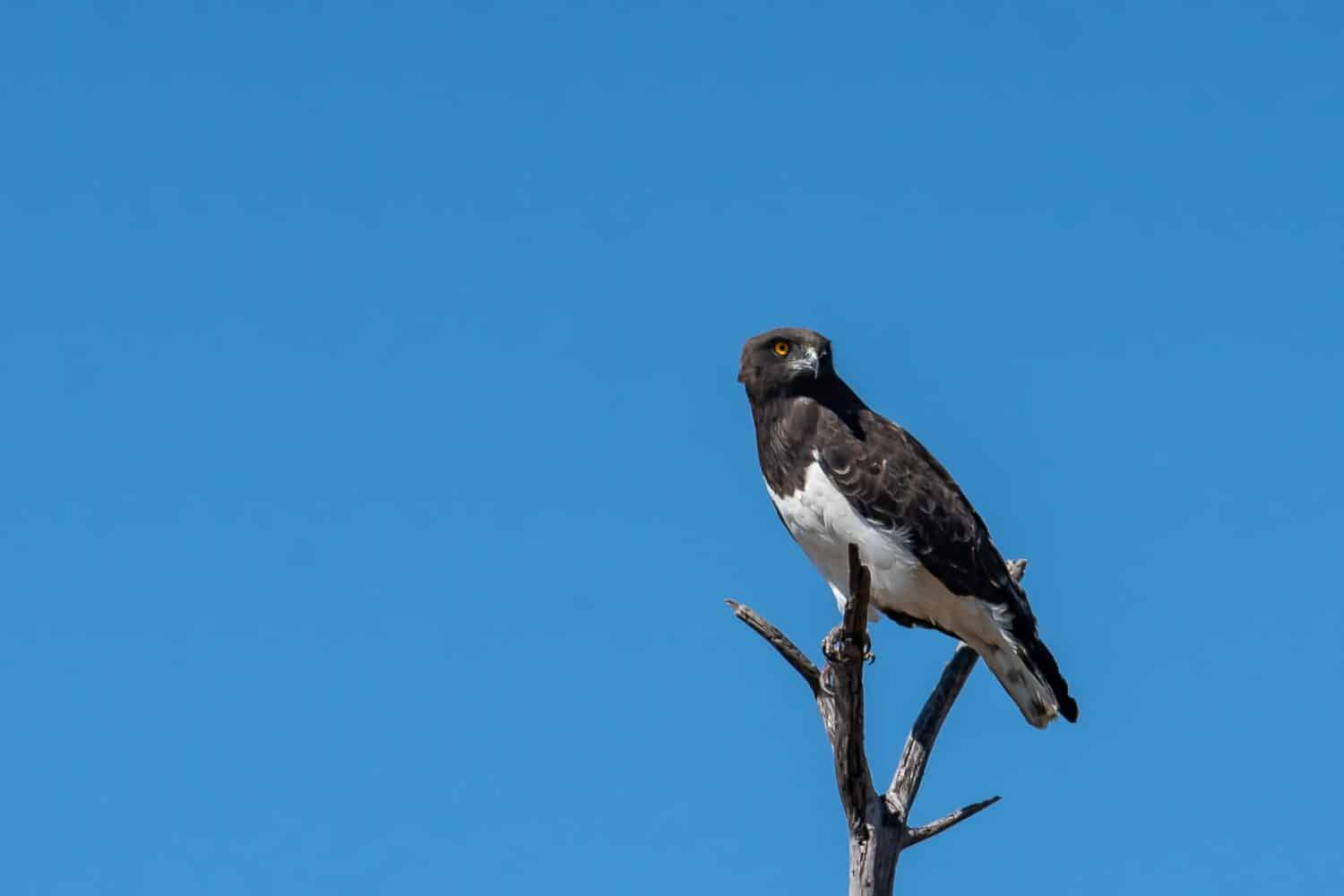
The black-chested snake eagle sports a distinctive black chest.
©Habiburstock99/Shutterstock.com
True to its name, this type of eagle is notable for its blackish-brown chest and head. Although it is typically solitary, it has been known to join communal roosts of up to 200 birds. It hunts snakes, especially venomous snakes as long as 32 inches.
- Genus: Circaetus
- Color: Blackish-brown chest and head; white undersides
- Length: 28 inches
- Wingspan: 5.3 to 6 feet
- Location: Africa
- Habitat: Savanna, shrubland, grassland, desert
- Conservation Status: Least Concern
20. Greater Spotted Eagle (Clanga clanga)
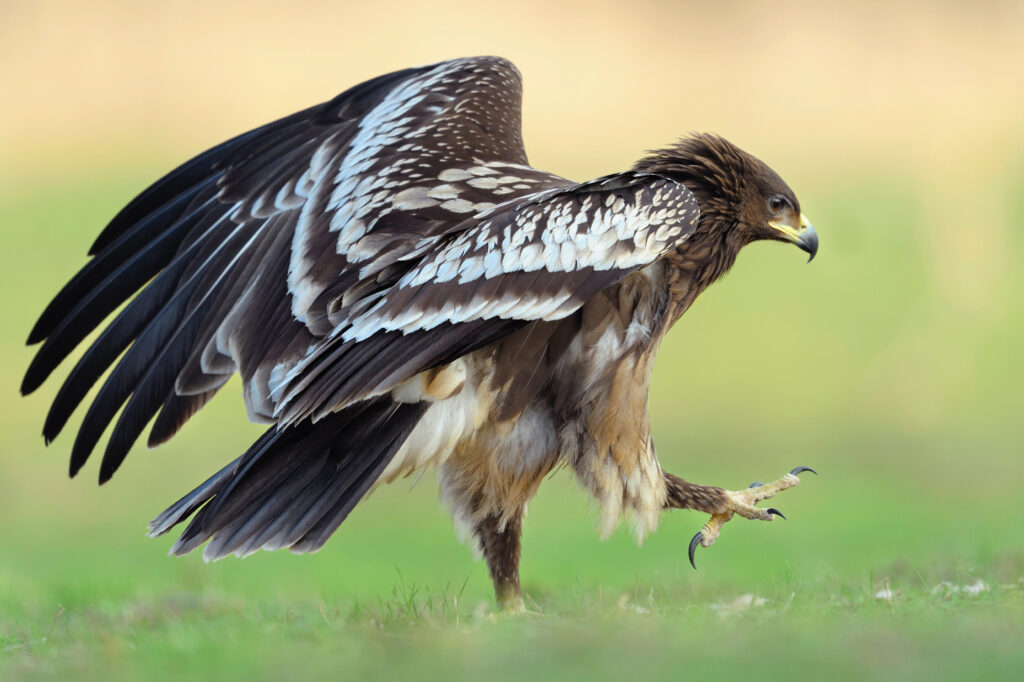
The greater spotted eagle prefers wetter habitats than most members of its genus.
©Vladimir Kogan Michael/Shutterstock.com
This species is also known simply as the spotted eagle. As a booted eagle, it has feathered legs. However, it prefers wetter habitats than most booted eagles. It hunts by gliding over its prey from concealed perches.
- Genus: Clanga
- Color: Blackish-brown
- Length: 23-29 inches
- Wingspan: 5-6 feet
- Location: Africa, Asia, Europe
- Habitat: Forest, shrubland, grassland, wetlands, marine (coastal and intertidal)
- Conservation Status: Vulnerable
21. Indian Spotted Eagle (Clanga hastata)

The Indian spotted eagle has the widest mouth of any spotted eagle.
©Anantha Jois/Shutterstock.com
This type of eagle is notable for having a broad head and the widest mouth of any spotted eagle. It is also more lightly colored than other members of its genus. Unlike many other raptors, it is relatively approachable.
- Genus: Clanga
- Color: Brown to dark brown
- Length: 24-26 inches
- Wingspan: 5 to 5.5 feet
- Location: Asia
- Habitat: Forest, wetlands
- Conservation Status: Vulnerable
22. Lesser Spotted Eagle (Clanga pomarina)
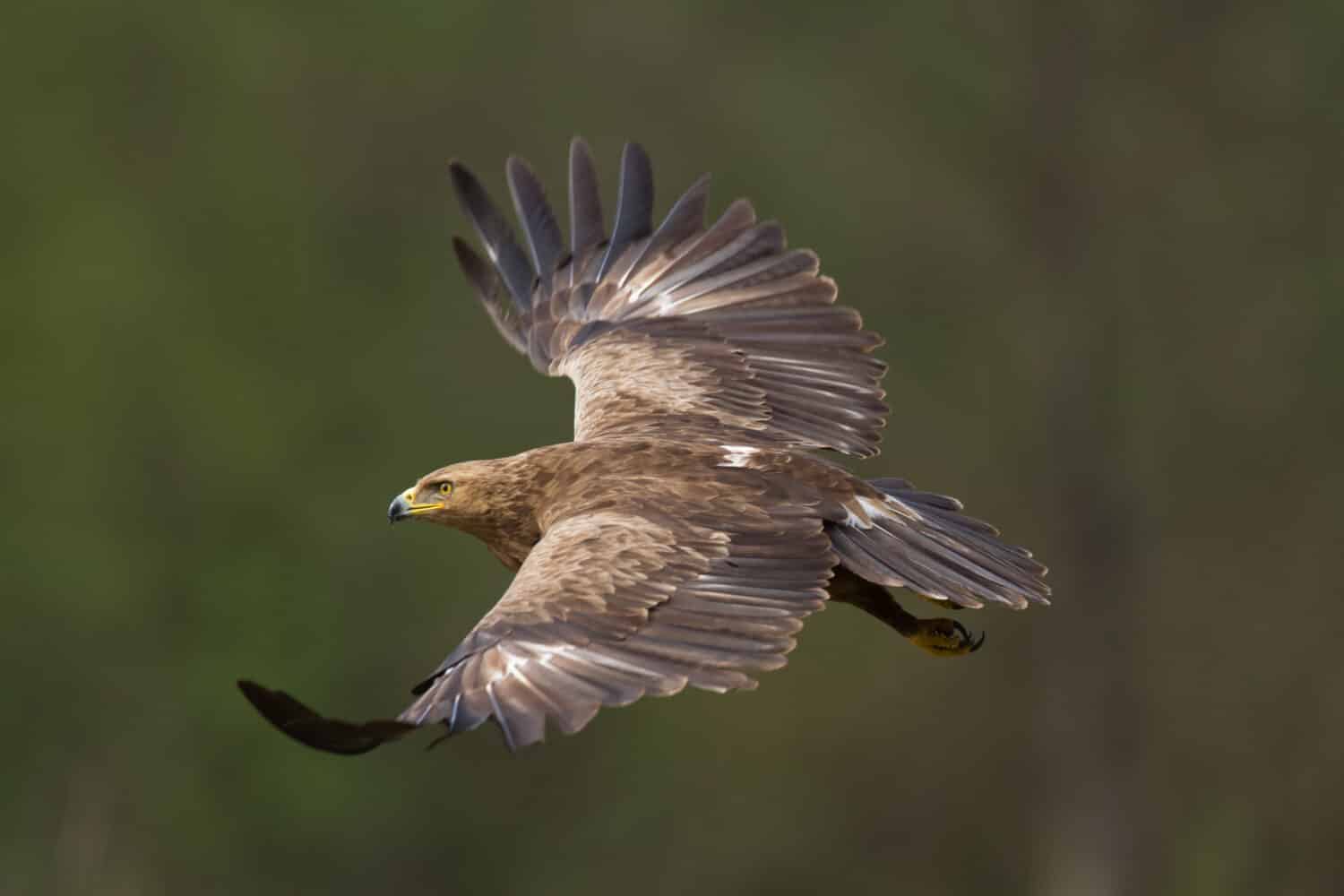
The lesser spotted eagle has a distinctive white V on its rump.
©Marcin Perkowski/Shutterstock.com
This species has a unique call that sounds like the yip of a dog. Unusually, it occasionally mates with the greater spotted eagle to produce hybrid young. A clearly-defined white V marks its rump.
- Genus: Clanga
- Color: Dark brown; pale brown head and wing coverts; white patch on upper wings; white V on rump
- Length: 25 inches
- Wingspan: 4.8 to 5.6 feet
- Location: Africa, Asia, Europe
- Habitat: Forest, savanna, grassland, wetlands
- Conservation Status: Least Concern
23. Congo Serpent-Eagle (Dryotriorchis spectabilis)
This type of eagle is the only member of the monotypic genus Dryotriorchis. Its superior eyesight renders it especially adept at hunting in the dark understories of the African rainforest. It hunts snakes, chameleons, and toads by dropping them from its perch in the trees.
- Genus: Dryotriorchis
- Color: Dark chocolate brown; blackish-brown crown and upper neck; white underside with dark spots and rufous wash
- Length: 21-24 inches
- Wingspan: 3 to 3.5 feet.
- Location: Africa
- Habitat: Forest
- Conservation Status: Least Concern
24. Madagascar Serpent-Eagle (Eutriorchis astur)
This species is endemic to the African island country of Madagascar where it inhabits dense evergreen forests. At one point, there were no sightings of the bird from 1930 to 1977, leading scientists to believe the species was extinct. Renewed sightings reversed this belief; however, the species is currently endangered.
- Genus: Eutriorchis
- Color: Dark grey on back; lighter grey on belly, breast, and throat; dark barring on body
- Length: 22-26 inches
- Wingspan: 3 to 3.6 feet
- Location: Africa (Madagascar)
- Habitat: Forest
- Conservation Status: Endangered
25. Black-Chested Buzzard-Eagle (Geranoaetus melanoleucus)
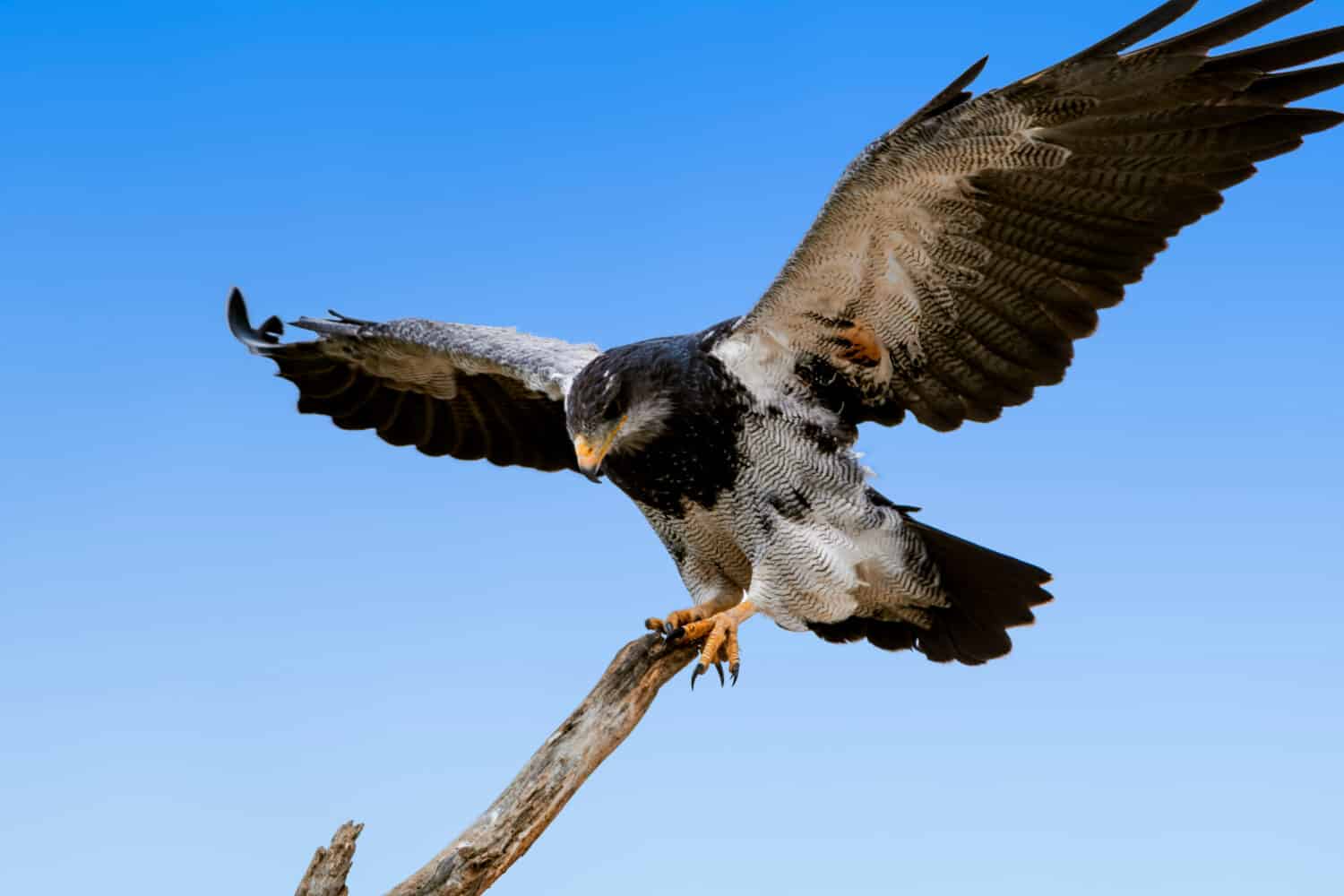
The black-chested buzzard-eagle has an impressive wingspan of up to 6.6 feet.
©Nick Pecker/Shutterstock.com
This massive eagle is notable for its powerful build and impressive wingspan. In fact, its wings are so long and its tail so short that, when perched, it appears tailless. True to its name, it has a black chest. Interestingly, one of its varied cries sounds uncannily like wild human laughter.
- Genus: Geranoaetus
- Color: Dark grey back and chest (sometimes with black, brown, or blue hue); white undersides (sometimes with dark stripes)
- Length: 24-30 inches
- Wingspan: 4.9 to 6.6 feet
- Location: South America
- Habitat: Savanna, shrubland, grassland, rocky areas
- Conservation Status: Least Concern
26. White-Tailed Sea-Eagle (Haliaeetus albicilla)

The white-tailed sea-eagle is one of the largest birds of prey with a wingspan of up to eight feet.
©Mark Medcalf/Shutterstock.com
This species is remarkable for being one of the largest birds of prey in the world as well as the largest type of eagle found in Europe. With a maximum wingspan of eight feet, it may also have the greatest wingspan of any eagle worldwide. As its name suggests, its tail feathers are white in color. Alternate names for this species include the white-tailed eagle, ern (or erne), gray sea eagle, and Eurasian sea eagle.
- Genus: Haliaeetus
- Color: Greyish-brown; paler head, neck, upper breast, and wing coverts; white tail
- Length: 26-37 inches
- Wingspan: 5.8 to 8 feet
- Location: Asia, Europe
- Habitat: Forest, grassland, wetlands, marine (coastal, intertidal, neritic)
- Conservation Status: Least Concern
27. Bald Eagle (Haliaeetus Ieucocephaus)
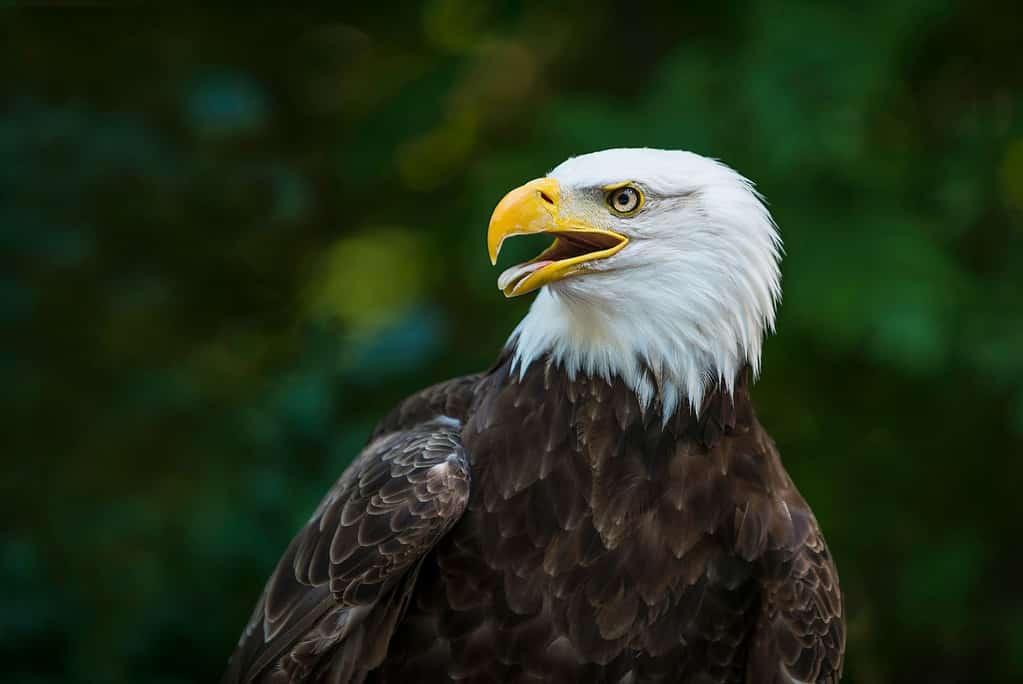
The bald eagle dives at speeds of up to 99 miles per hour.
©iStock.com/hsun337 – License
The bald eagle is perhaps most famous for being the national bird of the United States as well as a sacred Indigenous symbol. Its name refers to its white head, which stands in sharp contrast to the rest of its body. This species feeds mainly on fish, plucking them from the water with its sharp talons. It glides at speeds of up to 43 miles per hour and dives at up to 99 miles per hour.
- Genus: Haliaeetus
- Color: Brown; white head and tail
- Length: 28-40 inches
- Wingspan: 5.9 to 7.6 feet
- Location: Asia (Russia), Europe (Ireland), North America, South America
- Habitat: Forest, shrubland, grassland, wetlands, marine (neritic and intertidal)
- Conservation Status: Least Concern
28. White-Bellied Sea-Eagle (Haliaeetus leucogaster)
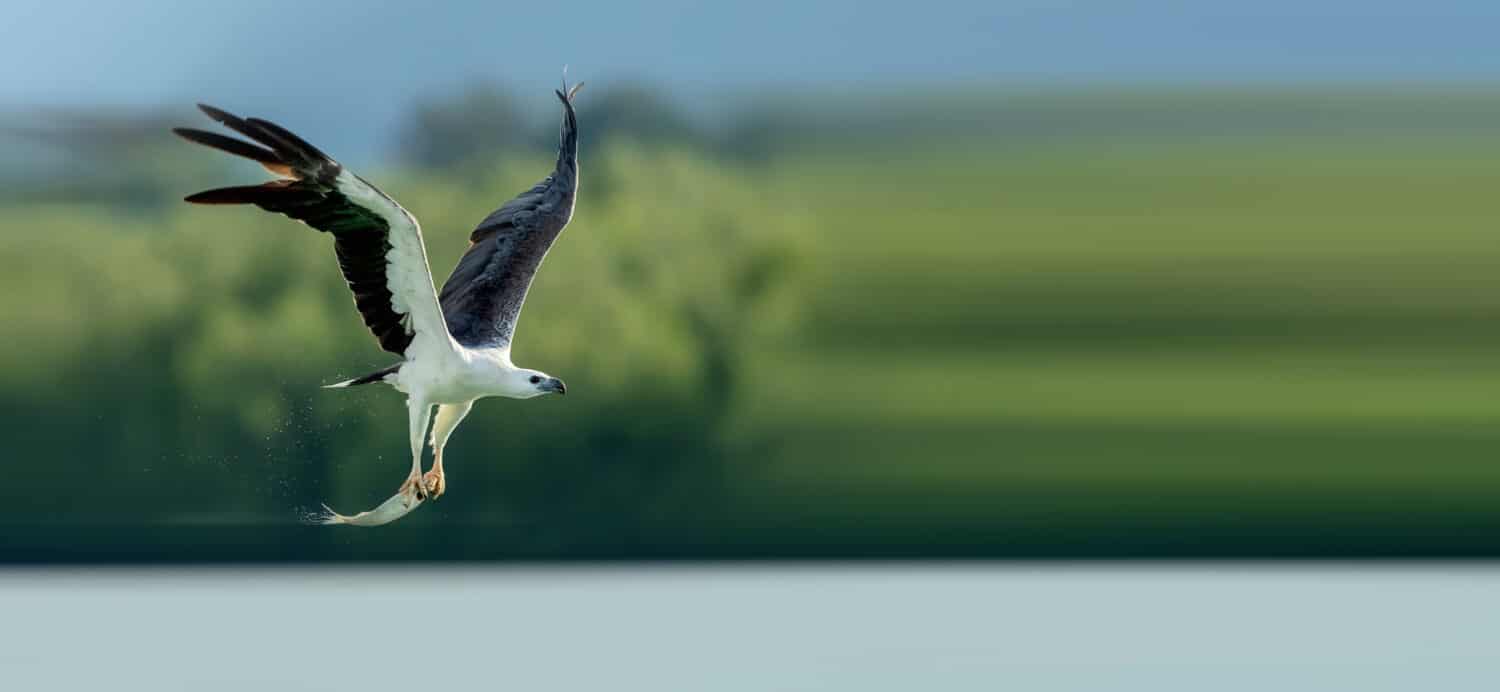
The white-bellied sea-eagle’s cry resembles the honk of a goose.
©Wang LiQiang/Shutterstock.com
Also known as the white-breasted sea-eagle, this species lives up to its name with a white breast and belly. Its other alternate names include white-bellied fish hawk, white-eagle, and grey-backed sea-eagle. Strangely enough, its call is more of a goose-like honk than a screech. The species is monogamous with pairs remaining together until death, upon which the surviving member seeks out a new mate.
- Genus: Haliaeetus
- Color: Grey; white head, breast, belly, and tail
- Length: 26-35 inches
- Wingspan: 5.8 to 7.2 feet
- Location: Asia, Oceania
- Habitat: Wetlands, marine (coastal, intertidal, neritic)
- Conservation Status: Least Concern
29. Pallas’s Fish-Eagle (Haliaeetus leucoryphus)
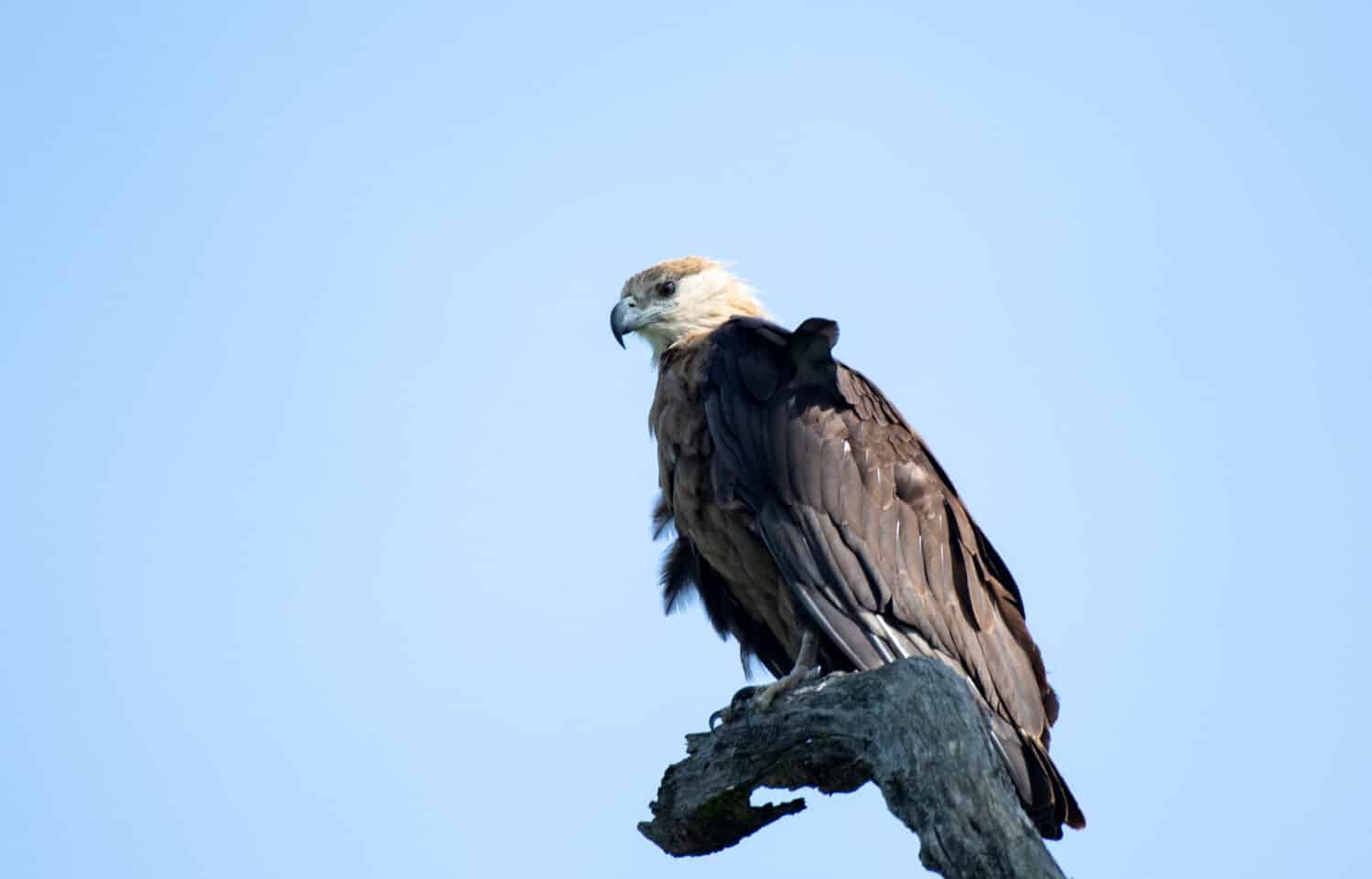
Pallas’s fish eagle is capable of lifting loads heavier than itself.
©Supriyo Ghoshal/Shutterstock.com
Like many opportunistic raptors, this type of eagle has a widely varied diet. Although it prefers freshwater fish, it will also eat water birds, frogs, reptiles like snakes, insects, and carrion. Remarkably, observers have seen these eagles carrying off animals heavier than themselves.
- Genus: Haliaeetus
- Color: Rufous (back); dark brown wings; sandy-brown hood; whitish face; black tail with white stripe
- Length: 28-33 inches
- Wingspan: 5.9 to 7.9 feet
- Location: Asia, Europe
- Habitat: Wetlands (inland)
- Conservation Status: Endangered
30. Steller’s Sea-Eagle (Haliaeetus pelagicus)
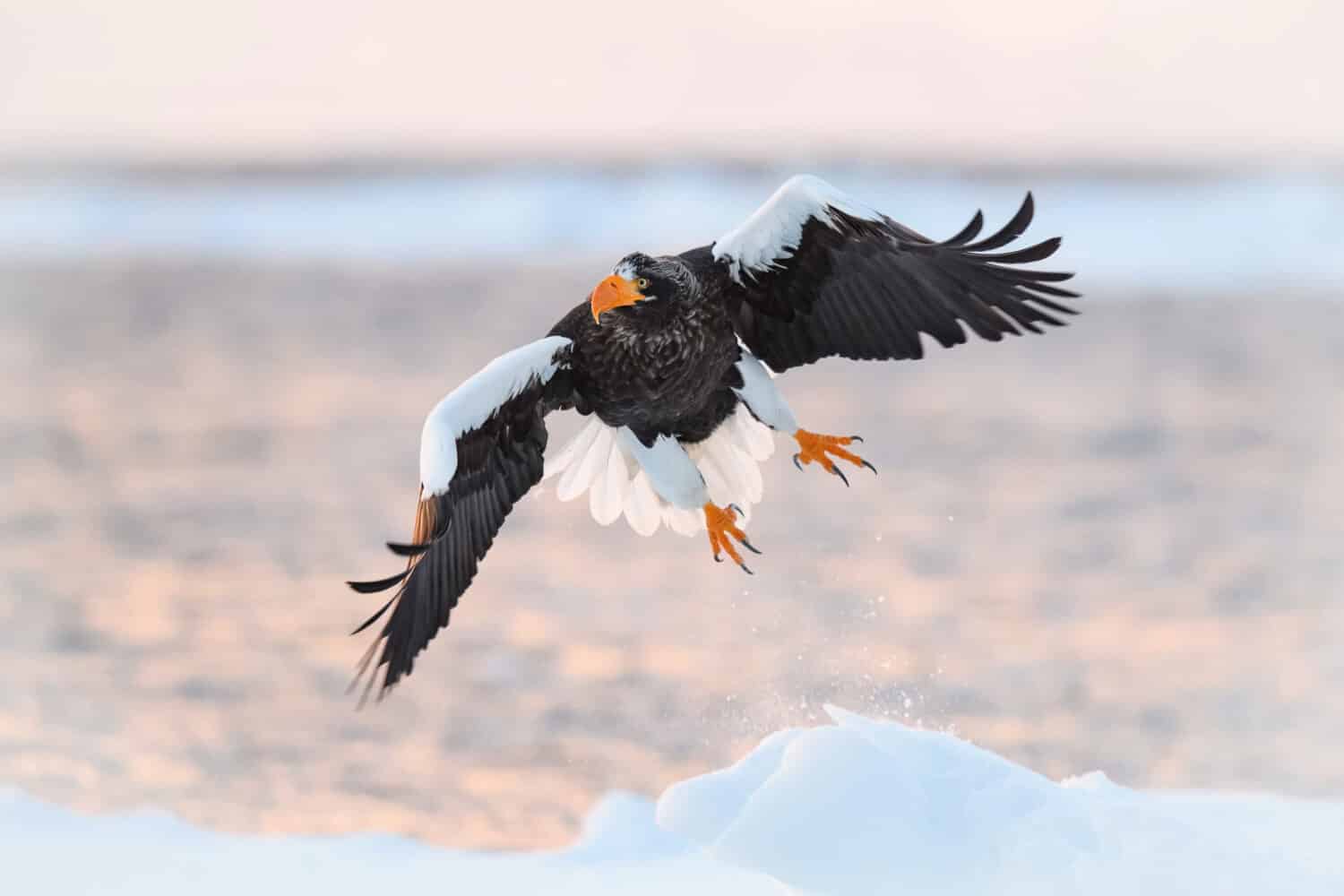
Steller’s sea eagle is arguably the heaviest eagle in the world.
©Petr Simon/Shutterstock.com
This species is famous for typically being the heaviest eagle in existence, though the harpy eagle and the Philippine eagle are contenders for the title. In addition to this, the species also has a massive wingspan. Its barking cry is distinctive for being loud and deep. Though it is usually dark brown with white accents, some individuals are born as the rare dark morph. The only white plumage on these birds occurs in their tails.
- Genus: Haliaeetus
- Color: Dark brown to black; white wing coverts, thighs, under-tail coverts, and tail
- Length: 34-41 inches
- Wingspan: 6.4 to 8.2 feet
- Location: Asia, North America
- Habitat: Forest, wetlands (inland), rocky areas, marine (coastal, neritic, intertidal)
- Conservation Status: Vulnerable
31. Sanford’s Sea-Eagle (Haliaeetus sanfordi)

Sanford’s sea-eagle is endemic to the Solomon Islands.
©Agami Photo Agency/Shutterstock.com
This type of eagle is endemic to the Solomon Islands archipelago and is the only large predator inhabiting the Solomon Islands. Although it mainly hunts fish, molluscs, sea tortoises, crabs, and sea snakes, it also occasionally grabs birds and bats from the forest canopy.
- Genus: Haliaeetus
- Color: Dark brown to greyish-black; bright brown on head and neck; underparts brown, reddish brown, or dark brown
- Length: 28-35 inches
- Wingspan: 5.4 to 6 feet
- Location: Oceania (Papua New Guinea and Solomon Islands)
- Habitat: Forest, wetlands, marine (intertidal)
- Conservation Status: Vulnerable
32. African Fish-Eagle (Haliaeetus vocifer)
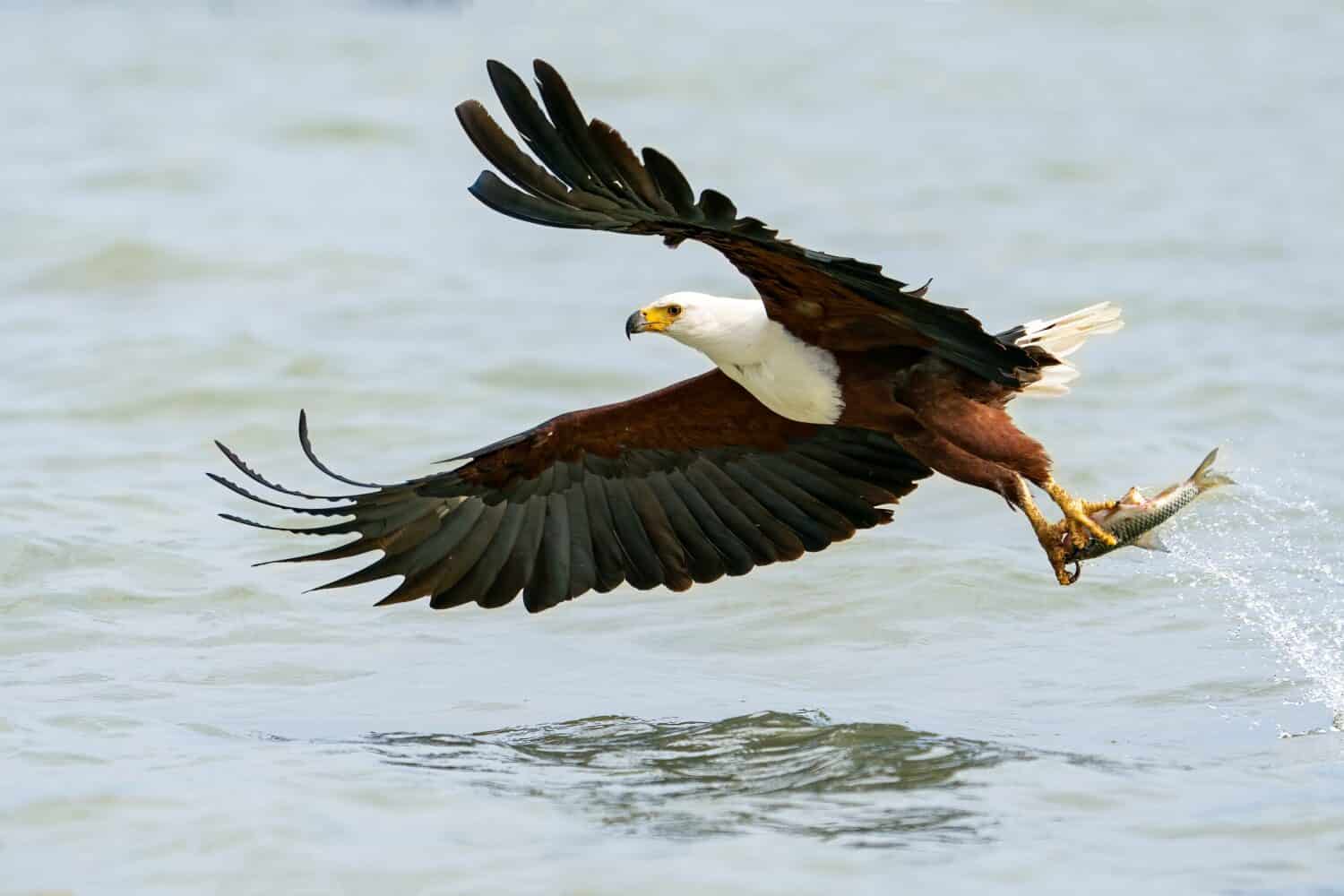
The African fish-eagle inhabits areas around large bodies of water.
©Tomas Drahos/Shutterstock.com
This species of eagle is endemic to sub-Saharan Africa where it lingers around large bodies of open water. Due to its white head, it closely resembles the bald eagle, though their ranges do not overlap. Its evocative cry is especially shrill when coming from a male. It feeds on fish and birds as well as more unusual animals like baby crocodiles and dik diks.
- Genus: Haliaeetus
- Color: Brown body; black wings; white head
- Length: 25 to 29.5 inches
- Wingspan: 6.6 to 7.9 feet
- Location: Africa
- Habitat: Forest, wetlands (inland), marine (coastal, neritic)
- Conservation Status: Least Concern
33. Madagascar Fish-Eagle (Haliaeetus vociferoides)
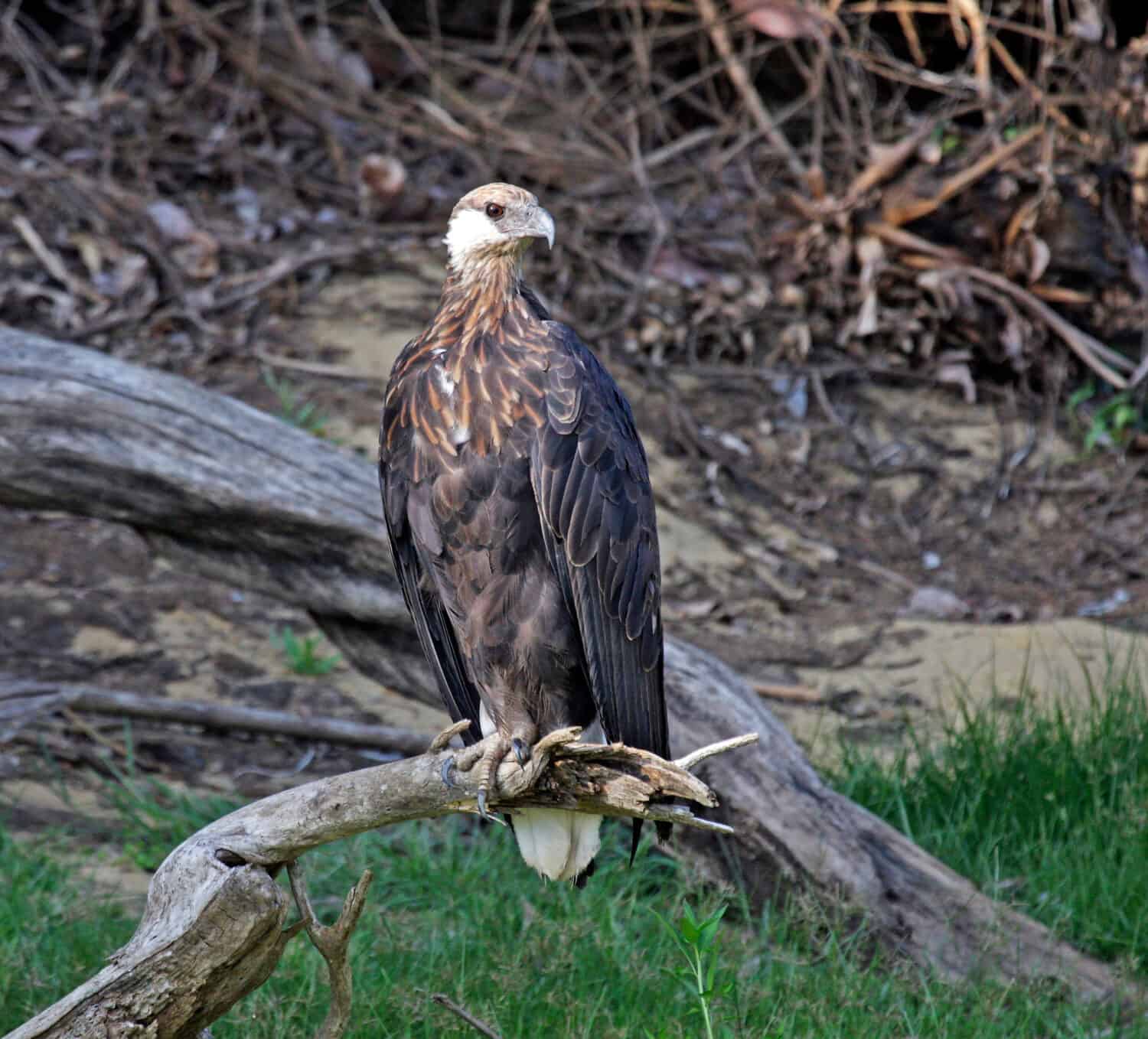
The Madagascar fish-eagle is critically endangered.
©Agami Photo Agency/Shutterstock.com
Although many species of eagles suffer from declining populations, the Madagascar fish-eagle is one of the few that are critically endangered. Endemic to Madagascar, it has few options for repopulation. It is closely related to the African fish-eagle, though it has a tan rather than a white head.
- Genus: Haliaeetus
- Color: Dark brown; pale brown or tan head; white tail
- Length: 23.5 to 26 inches
- Wingspan: 5.4 to 5.9 feet
- Location: Africa (Madagascar)
- Habitat: Forest, wetlands (inland), marine (coastal, intertidal, neritic)
- Conservation Status: Critically Endangered
34. Harpy Eagle (Harpia harpyja)
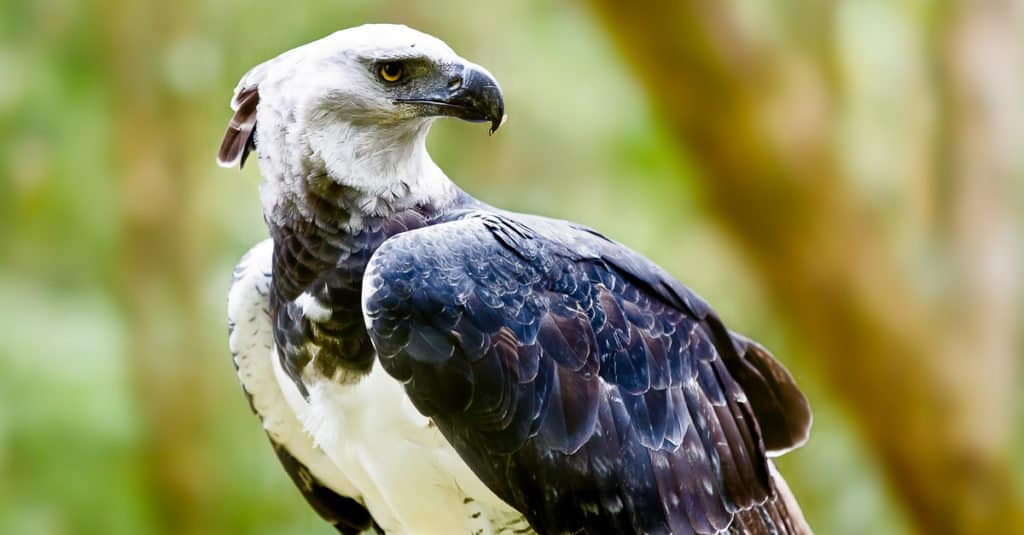
The majestic harpy eagle has a wingspan of over seven feet.
©MarcusVDT/Shutterstock.com
Also known as the American harpy eagle, this type of eagle derives its name from the half-human, half-bird harpy of Greco-Roman legend. It is the only member of the monotypic genus Harpia. Famously, it is one of the three largest eagles in the world, contending with the Philippine eagle and Steller’s sea-eagle. Its talons are larger than those of any living eagle, helping it to carry loads up to approximately half its own body weight.
- Genus: Harpia
- Color: Slate-black; broad black band across upper chest; white underside
- Length: 34-42 inches
- Wingspan: 5.8 to 7.4 feet
- Location: North America, South America
- Habitat: Forest, savanna
- Conservation Status: Vulnerable
35. Papuan Eagle (Harpyopsis novaeguineae)
Endemic to New Guinea, this species ranges throughout the island. Its proportions are somewhat strange, including an unusually prominent head and elongated legs. Alternate names for this species include the Papuan harpy eagle, New Guinea eagle, New Guinea harpy eagle, and kapul eagle.
- Genus: Harpyopsis
- Color: Greyish-brown; creamy underside
- Length: 30-35 inches
- Wingspan: 4 to 5.2 feet
- Location: Indonesia – Papua, Papua New Guinea
- Habitat: Forest, savanna, shrubland
- Conservation Status: Vulnerable
36. Ayres’s Hawk-Eagle (Hieraaetus ayresii)

Ayres’s hawk-eagle is known for targeting other birds.
©Daniel Danckwerts/Shutterstock.com
This type of eagle is remarkable for almost exclusively hunting other birds, intercepting them midair. Its favorite targets are doves and pigeons. However, it will sometimes target larger birds up to over twice its own size. Though its populations are small, scientists do not consider the species to be in serious danger at this time.
- Genus: Hieraaetus
- Color: Blackish with white mottling and white forehead; white underparts; ashy grey tail with black tip and bars
- Length: 17-22 inches
- Wingspan: 3.5 to 4.5 feet
- Location: Africa
- Habitat: Forest, savanna
- Conservation Status: Least Concern
37. Little Eagle (Hieraaetus morphnoides)
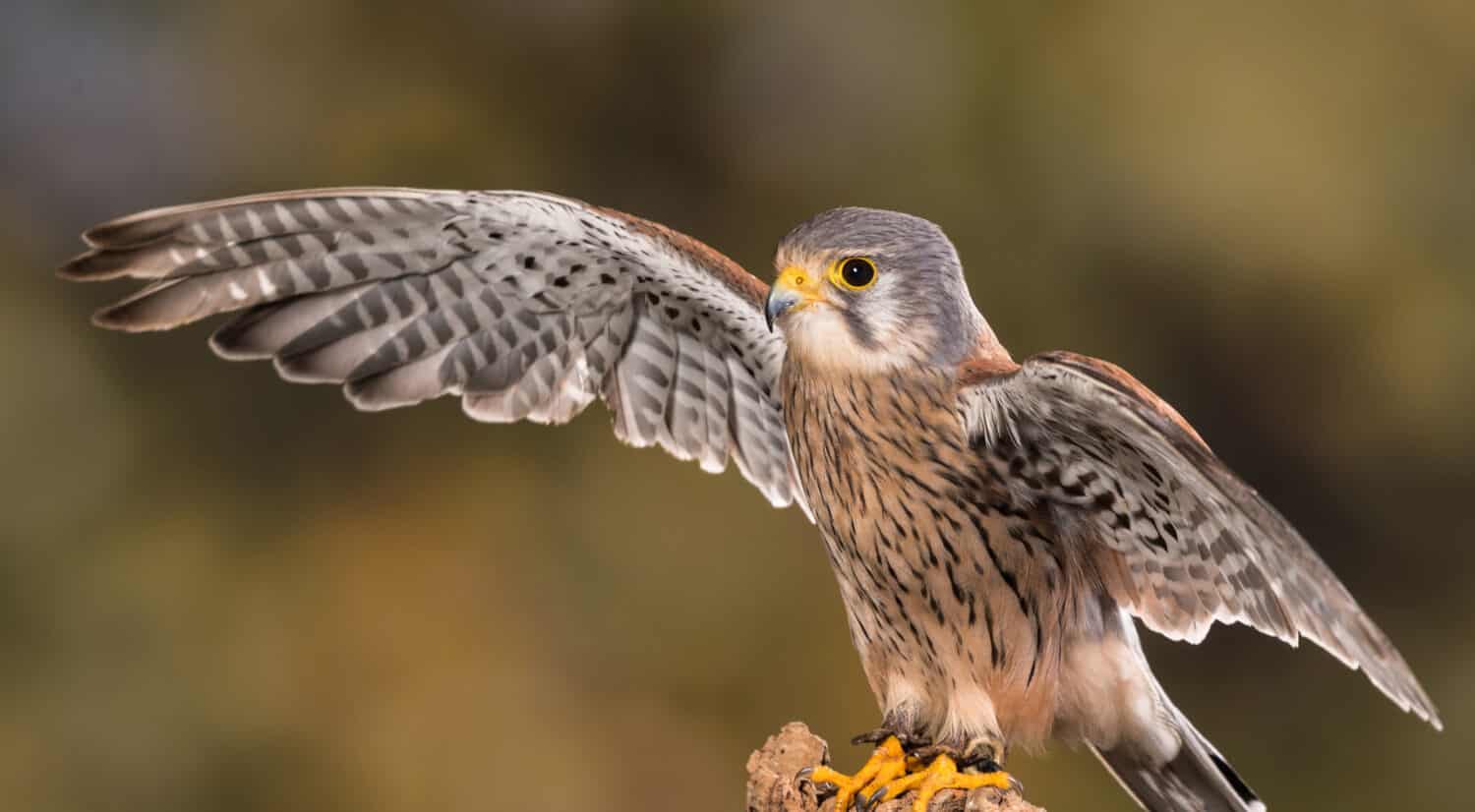
The little eagle is only about the size of a peregrine falcon.
©nataliatamkovich/Shutterstock.com
True to its name, the little eagle is very small in size with measurements similar to those of the peregrine falcon. Due to its size, it is limited to smaller mammals like rabbits as well as large insects. Declining populations of small mammals throughout Australia may threaten this species in the future.
- Genus: Hieraaetus
- Color: Light form (dark brown back and wings, black stripes on head and neck, sandy or pale underside); dark form (same as light form except head and underside are dark brown or rufous)
- Length: 17 to 21.5 inches
- Wingspan: 3.6 to 4.5 feet
- Location: Australia
- Habitat: Forest, shrubland, grassland
- Conservation Status: Least Concern
38. Booted Eagle (Hieraaetus pennatus)

The booted eagle is small but fast, stooping on its prey from above.
©Independent birds/Shutterstock.com
This species is small in size, comparable to the little eagle. It hunts by stooping on small mammals, birds, and reptiles. While populations in the northern hemisphere are migratory, populations in southern Africa remain in place. More research is needed on this inadequately studied species to better grasp the threats it faces.
- Genus: Hieraaetus
- Color: Light form (light grey, darker head and flight feathers); dark form (mid-brown plumage, dark grey flight feathers)
- Length: 16-22 inches
- Wingspan: 3.6 to 4.3 feet
- Location: Africa, Asia, Europe
- Habitat: Forest, shrubland, desert, marine (coastal)
- Conservation Status: Least Concern
39. Wahlberg’s Eagle (Hieraaetus wahlbergi)
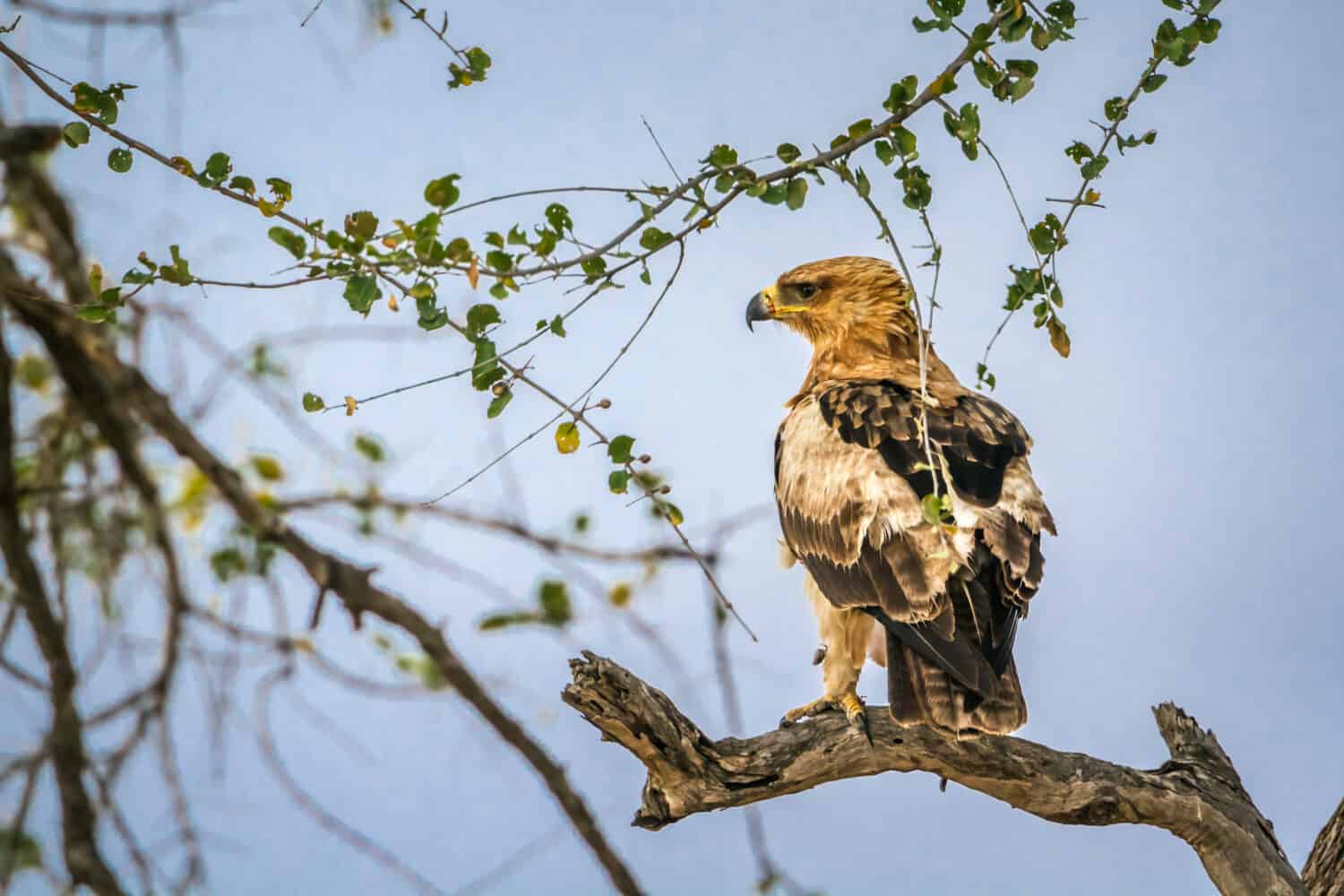
Wahlberg’s eagle has incredible speed and stamina over long distances.
©PACO COMO/Shutterstock.com
This type of eagle is especially notable for being able to cross large distances quickly. For example, researchers tracked a female in 1994 that covered 5,500 miles in nine months. The species’ aerial abilities also extend to stunning midair courtship displays. As predators, these raptors prey mainly on other birds, reptiles, and invertebrates like termites.
- Genus: Hieraaetus
- Color: Usually dark brown; grey undersides with dark markings; grey undertail with dark bars
- Length: 21-24 inches
- Wingspan: 4.3 to 4.8 feet
- Location: Africa
- Habitat: Forest, savanna, shrubland, wetlands (inland)
- Conservation Status: Least Concern
40. Pygmy Eagle (Hieraaetus weiskei)
Also known as the New Guinea hawk-eagle, this diminutive species is endemic to New Guinea. Next to the Great Nicobar serpent-eagle, it is the smallest extant eagle species. Initially, due to its size, scientists believed it to be a subspecies of the little eagle. It is quick and agile in the air, scanning the forest canopy for prey from above and then swiftly diving to attack.
- Genus: Hieraaetus
- Color: Dark morph (dark brown); light morph (light brown)
- Length: 15-19 inches
- Wingspan: 3.7 to 4.1 feet
- Location: Indonesia, Papua New Guinea
- Habitat: Forest
- Conservation Status: Least Concern
41. Lesser Fish-Eagle (Icthyophaga humilis)
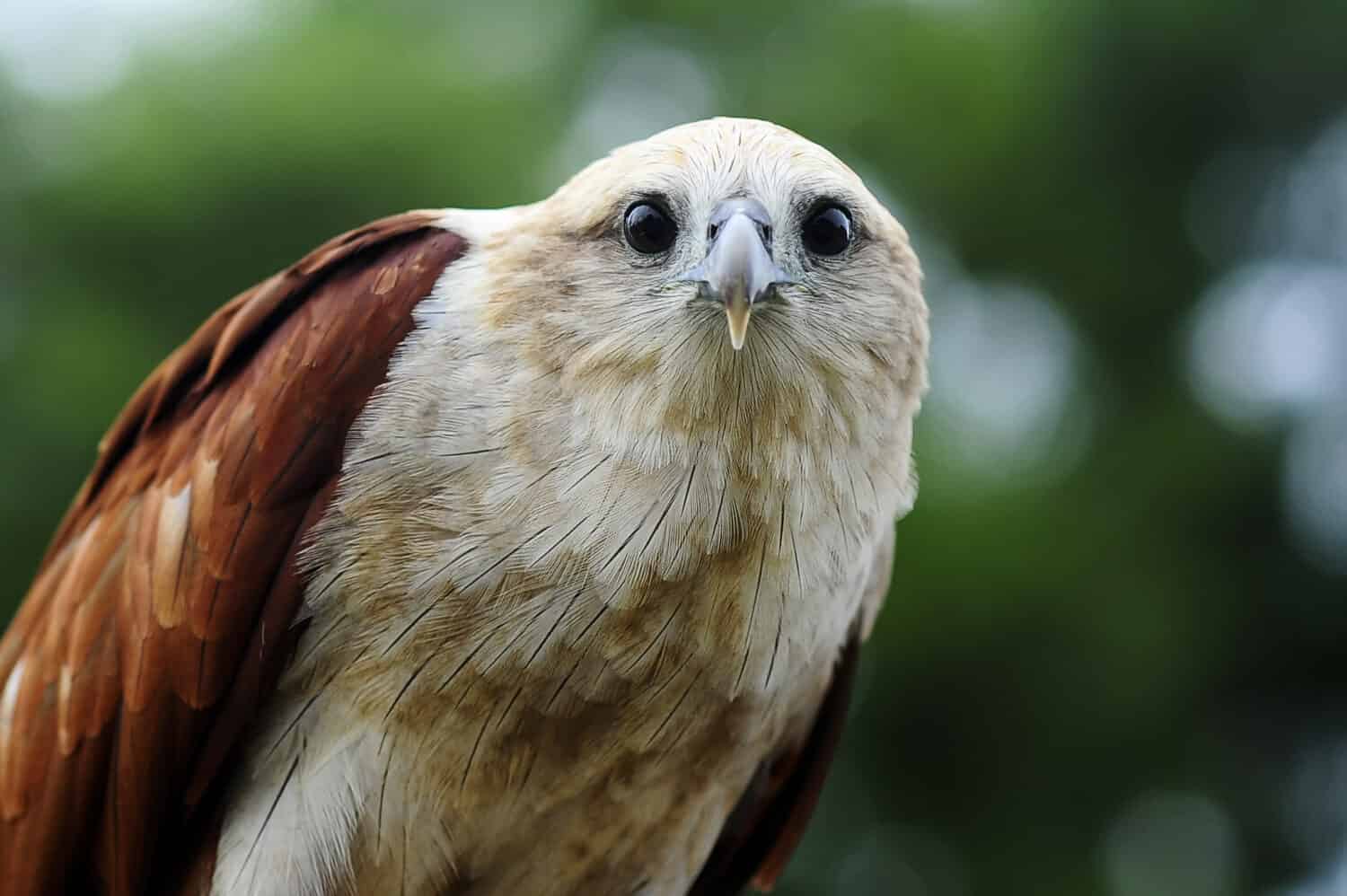
This type of eagle earned the modifier “lesser” due to its inferior size compared to its relative, the grey-headed fish-eagle. As this eagle mainly eats fish, it has adapted curved talons useful for plucking its prey from the water. It typically switches between several dedicated perches overlooking streams and rivers in order to view potential targets.
- Genus: Icthyophaga (alternately, some authorities place this species in the genus Haliaeetus)
- Color: Grey-brown; brown breast; white thighs and belly
- Length: 25-27 inches
- Wingspan: 3.9 to 5.4 feet
- Location: Asia
- Habitat: Wetlands (inland)
- Conservation Status: Near Threatened
42. Grey-Headed Fish-Eagle (Icthyophaga ichthyaetus)
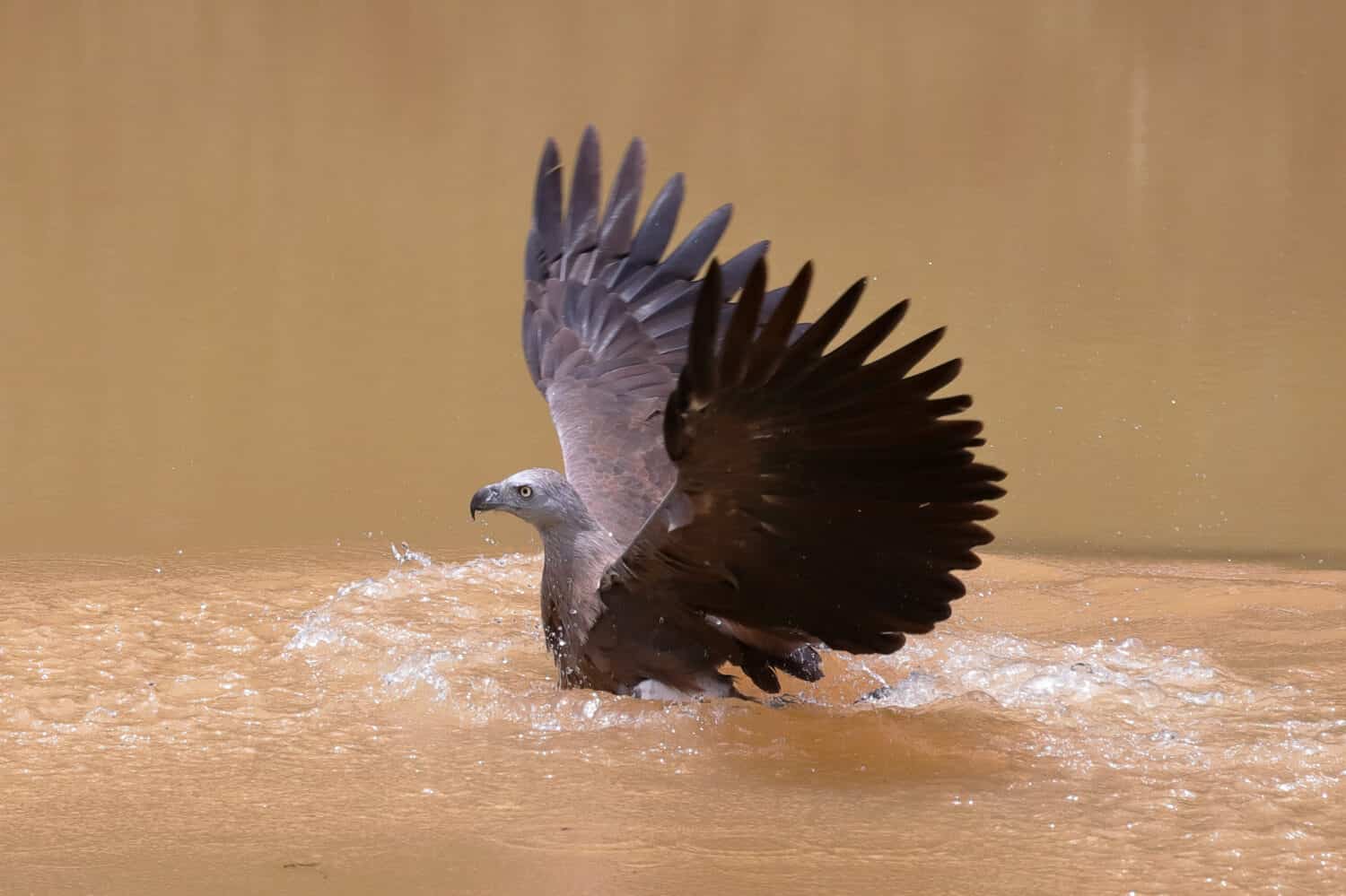
This species is notable for choosing to build its nests near bodies of water like rivers, streams, lakes, and lagoons. In Sri Lanka, the local people know it as the tank eagle due to its propensity for hanging around irrigation tanks. As its fondness for water might suggest, this eagle is a piscivore, occasionally expanding its diet to include small mammals, reptiles, and birds. Its similarity to the lesser fish-eagle has led some to confuse the two.
- Genus: Icthyophaga (alternately, some authorities place this species in the genus Haliaeetus)
- Color: Dark brown body; grey head; pale underbelly; white legs
- Length: 24 to 29.5 inches
- Wingspan: 5 to 5.6 feet
- Location: Asia
- Habitat: Wetlands (inland), marine (coastal, neritic)
- Conservation Status: Near Threatened
43. Black Eagle (Ictinaetus malaiensis)
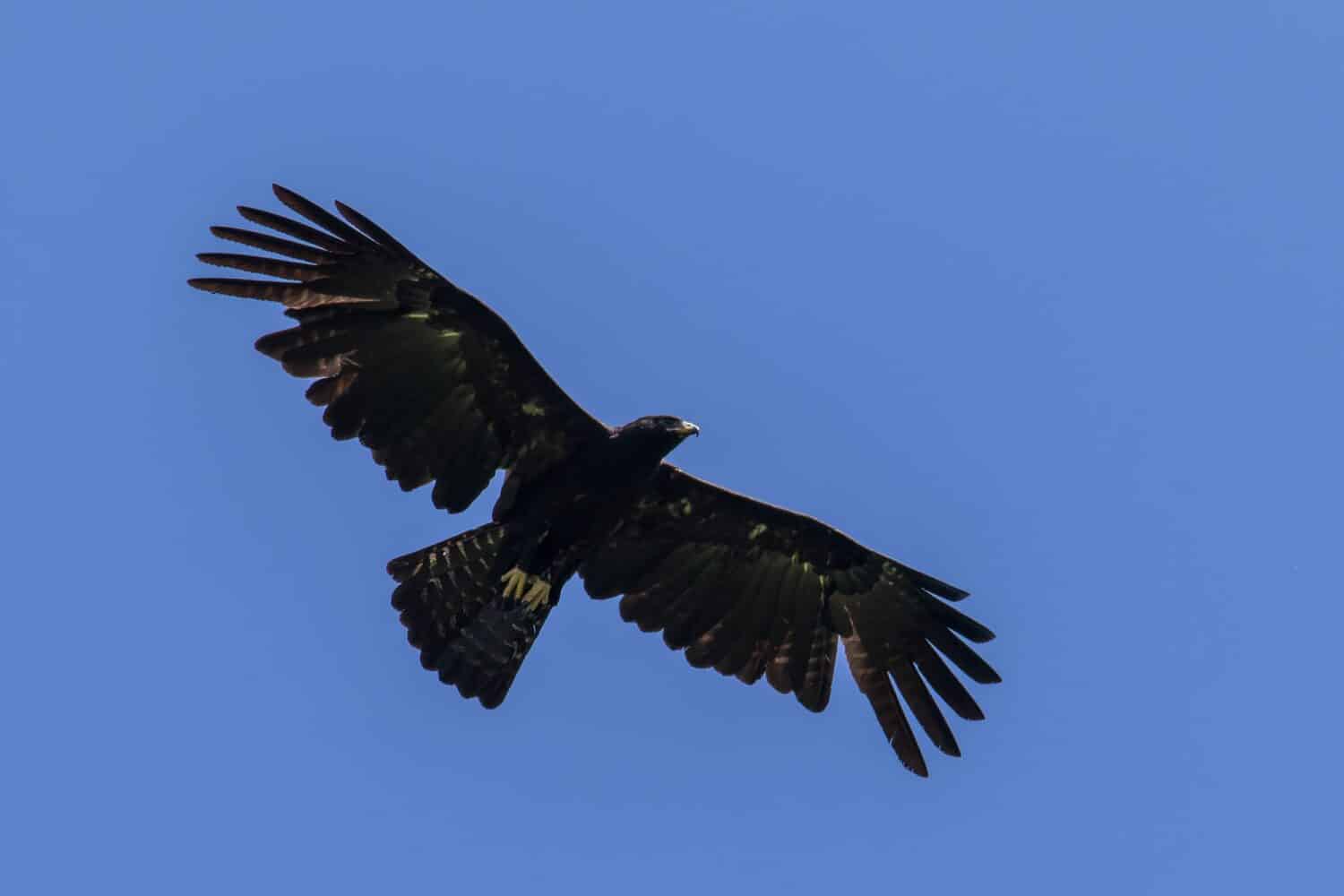
The black eagle is capable of soaring for long periods without rest.
©plains-wanderer/Shutterstock.com
Despite this species’ large size, its form is slender with wings that narrow toward the body. Its leisurely flight over the forest canopy gives it ample opportunity to search for vulnerable nests with eggs. In addition to eating eggs, it preys on small mammals like bats and squirrels as well as other birds. Its stamina allows it to soar for long periods without rest.
- Genus: Ictinaetus
- Color: Black
- Length: 30-32 inches
- Wingspan: 4.9 to 6 feet
- Location: Asia
- Habitat: Forest, shrubland
- Conservation Status: Least Concern
44. Long-Crested Eagle (Lophaetus occipitalis)
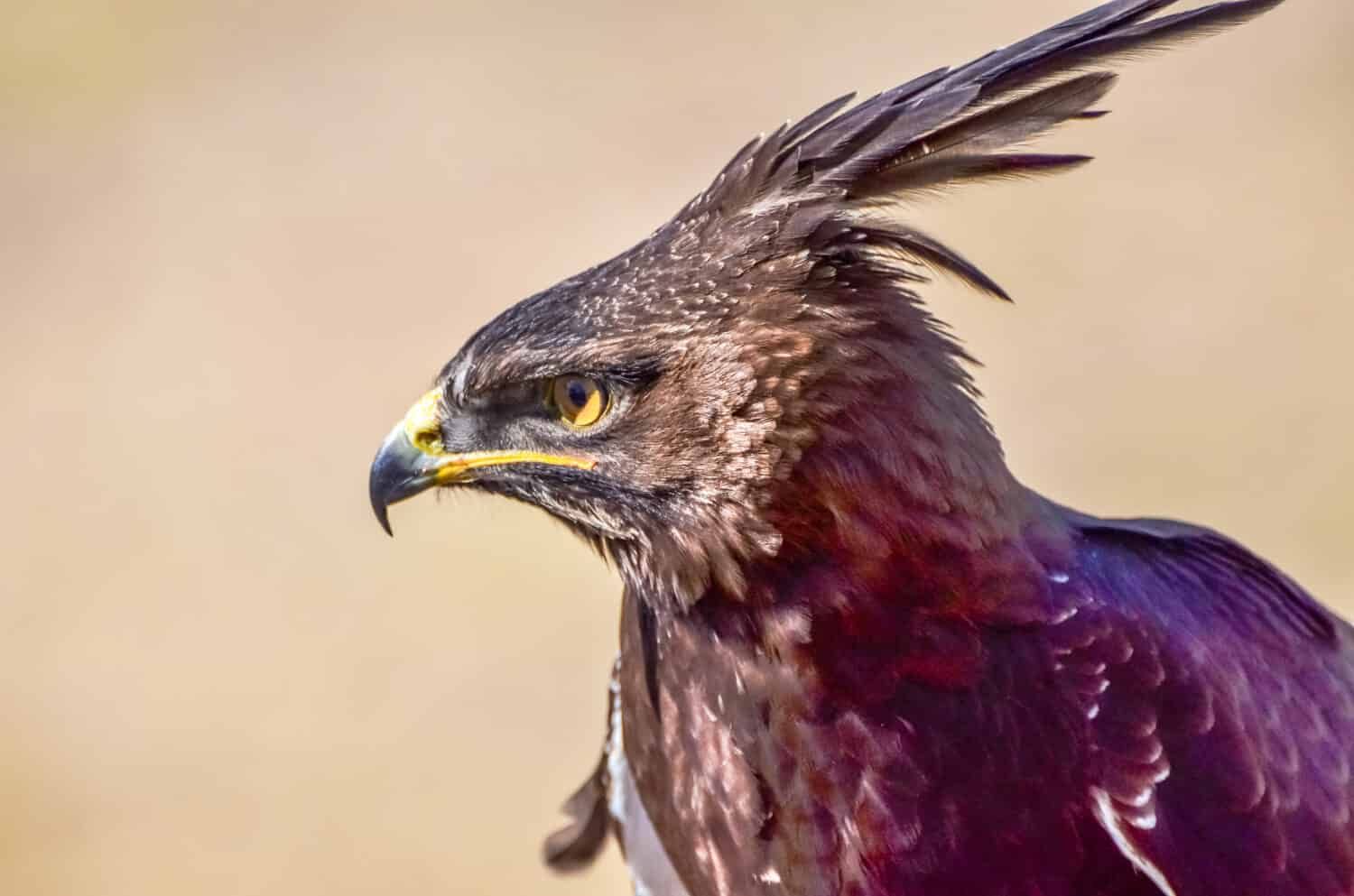
This type of eagle derives its name from the long, thin feathers protruding from the back of its head to form a distinctive crest. Its diet is almost completely comprised of rodents, though it will also eat other birds, frogs, lizards, and fish. Rather than soar in the air looking for prey, it is a “sit and wait hunter,” choosing a perch from which to observe potential prey.
- Genus: Lophaetus
- Color: Blackish-brown; white markings on wings; black tail with grey bars
- Length: 21-23 inches
- Wingspan: 3.7 to 4.2 feet
- Location: Africa
- Habitat: Forest, savanna, grassland, wetlands (inland)
- Conservation Status: Least Concern
45. Rufous-Bellied Eagle (Lophotriorchis kienerii)
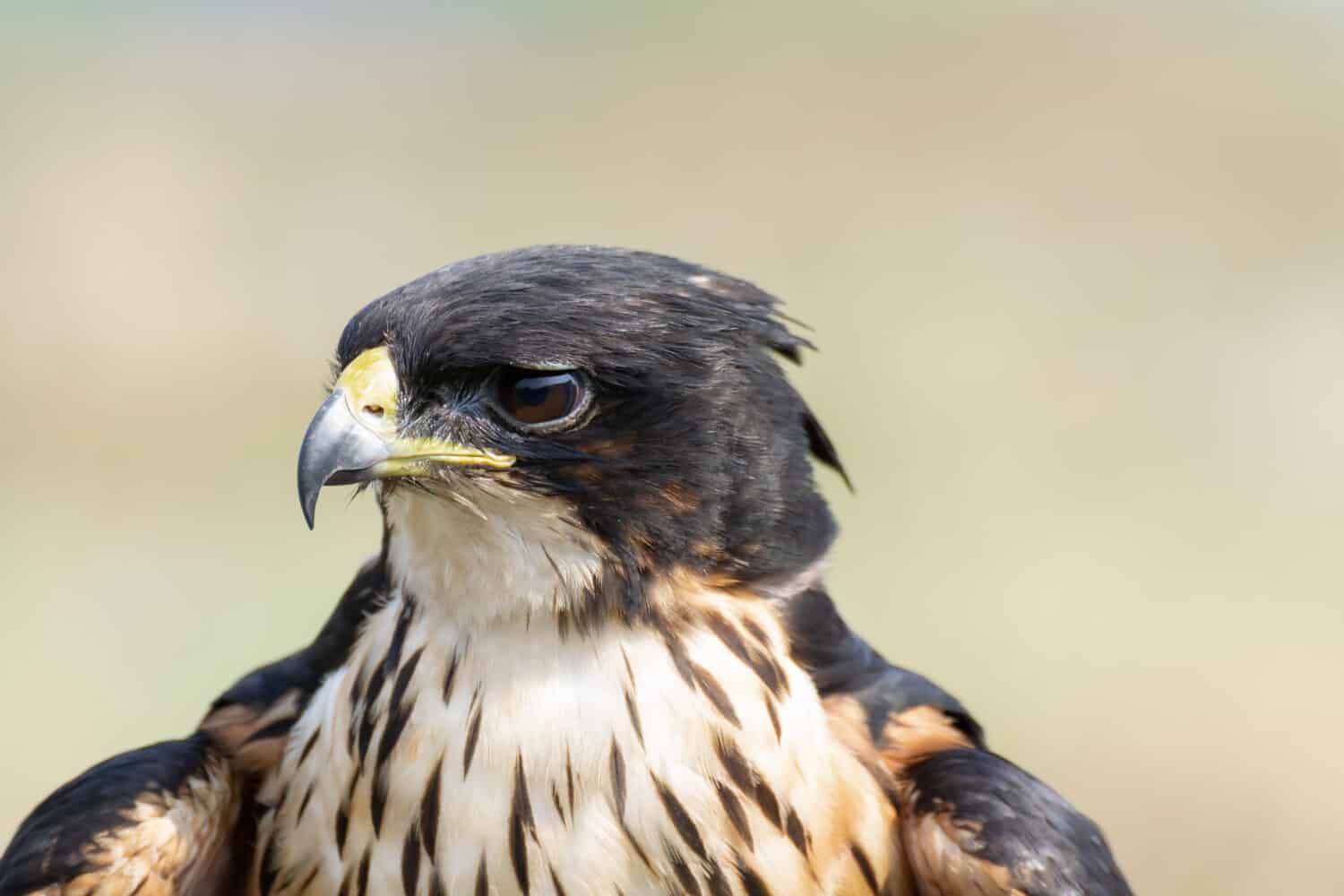
The rufous-bellied eagle spends its time flying over the forest canopy in search of prey.
©ITSUKY/Shutterstock.com
The rufous-bellied eagle is a physically striking bird with its black hood, chestnut underbelly, and white breast. Most commonly observed in flight rather than on perches, it soars over the forest canopy in search of prey before diving to capture it. In breeding season, it attempts to attract a mate by means of a display flight with stooping and wing-quivering.
- Genus: Lophotriorchis
- Color: Black hood; chestnut underparts and wing coverts; white throat and breast
- Length: 24 inches
- Wingspan: 3 to 4.2 feet
- Location: Asia
- Habitat: Forest
- Conservation Status: Near Threatened
46. Crested Eagle (Morphnus guianensis)
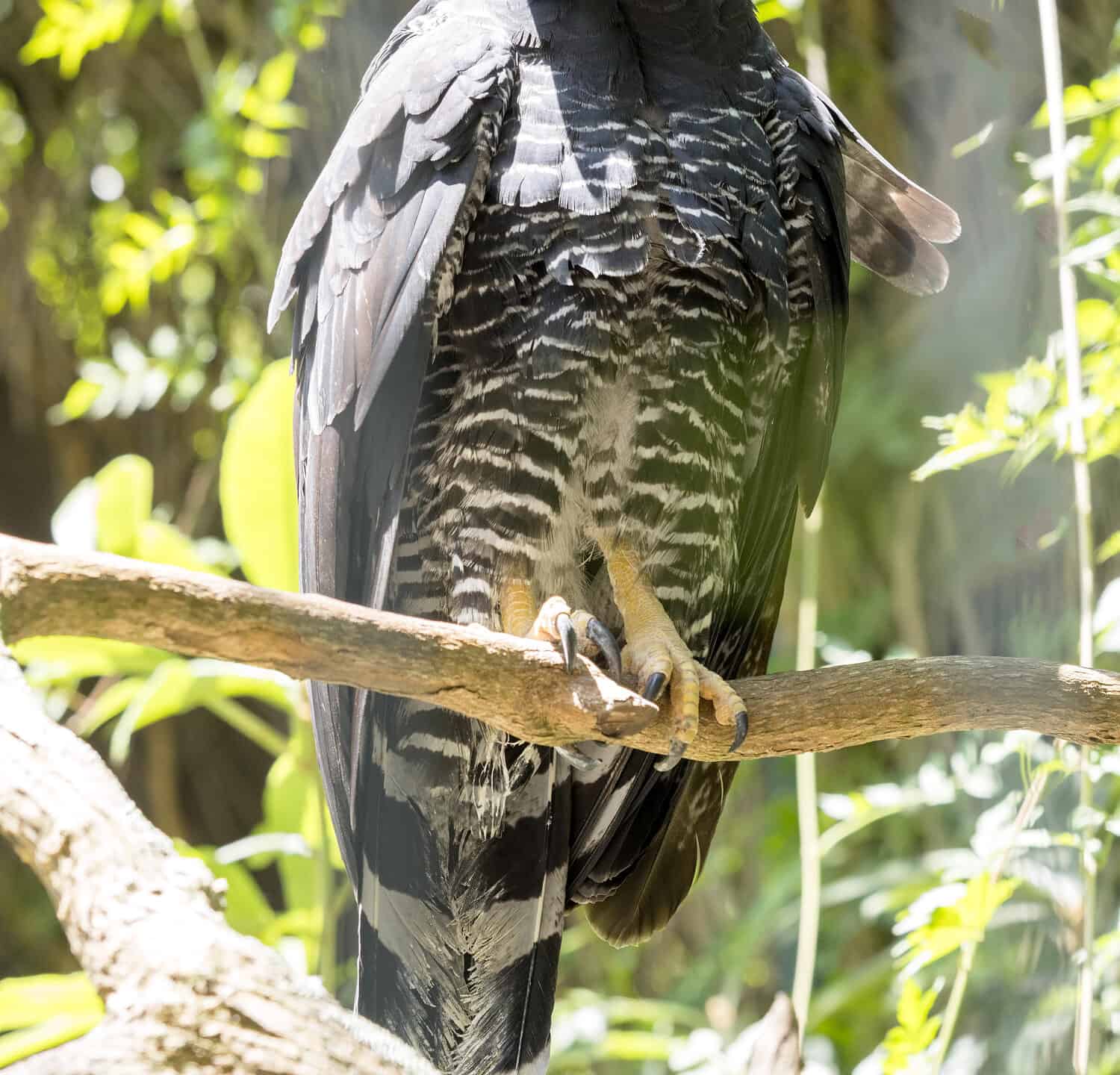
The crested eagle carries a distinctive feathery crest, giving the impression that its head is larger than it actually is. Amazingly, researchers have observed this species hunting small monkeys like capuchins, tamarins, and woolly monkeys. This is despite its general tendency to go after smaller prey, potentially to reduce competition with the larger harpy eagle. Its other prey includes mammals like opossums, snakes, and lizards.
- Genus: Morphnus
- Color: Light brownish-grey, sooty grey, or blackish body; white throat; dark spot on crest; dark mask over eyes
- Length: 28-35 inches
- Wingspan: 4.5 to 5.8 feet
- Location: North America, South America
- Habitat: Forest
- Conservation Status: Near Threatened
47. Blyth’s Hawk-Eagle (Nisaetus alboniger)
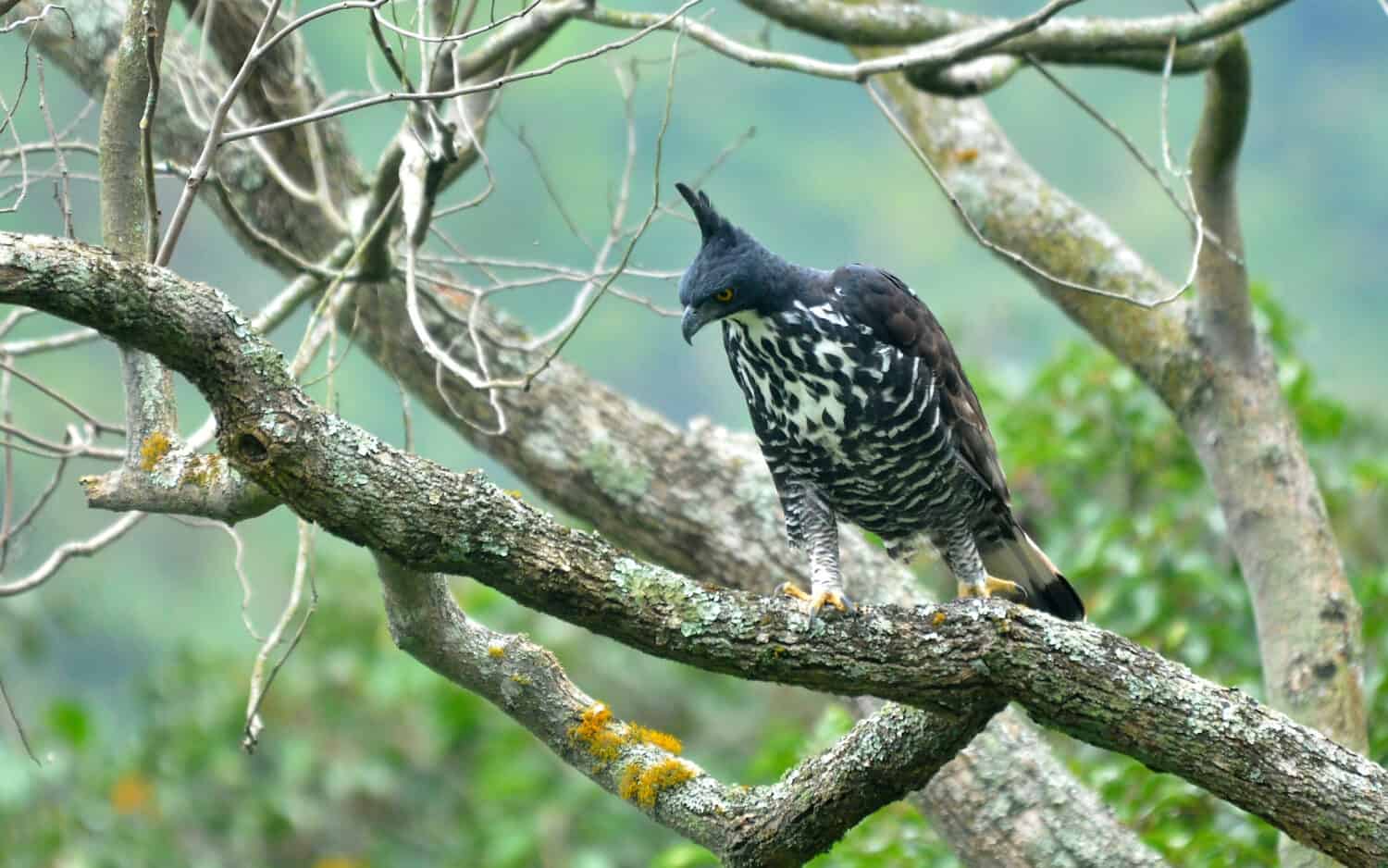
Blyth’s hawk-eagle builds its stick nest in a tree.
©MrKumai.blogspot.com/Shutterstock.com
This type of eagle sports a striking feathery crest as well as a distinctive spotted and barred breast and underbelly. Like many eagles, it builds a nest made of sticks in a tree. Because it only lays a single egg at a time, its populations are slow to recover from any losses.
- Genus: Nisaetus
- Color: Black above; black-spotted breast; barred underbelly; white band on tail
- Length: 20-24 inches
- Wingspan: 3.3 to 3.8 feet
- Location: Asia
- Habitat: Forest
- Conservation Status: Least Concern
48. Javan Hawk-Eagle (Nisaetus bartelsi)
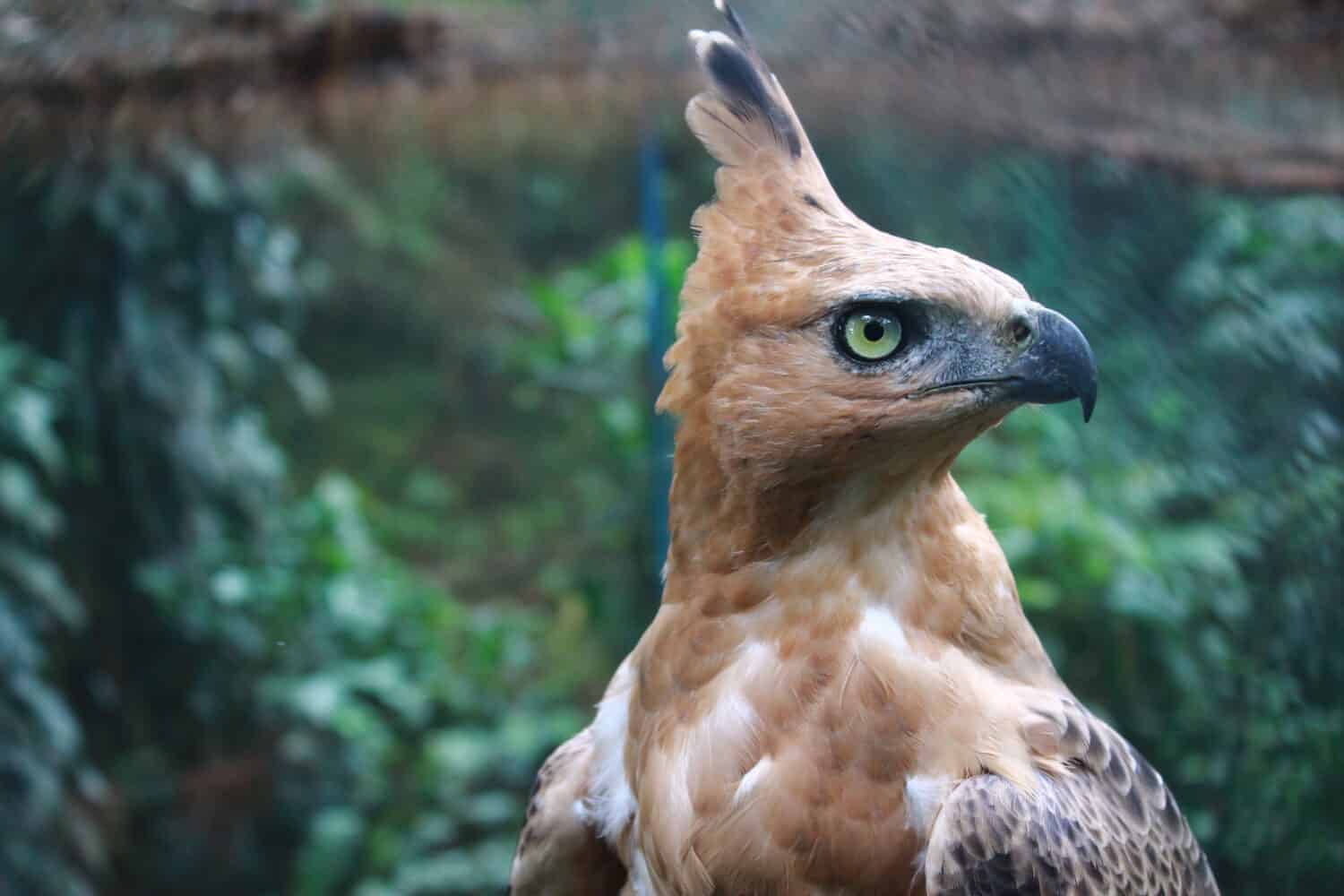
The Javan hawk-eagle is endemic to the island of Java.
©1346291609/Shutterstock.com
Endemic to the Indonesian island of Java, the Javan hawk-eagle is one of the rarest raptors in the world. The IUCN estimates that only 300-500 mature individuals currently remain in the wild. A striking bird, it sports a black feathery crest on its head and a barred underbelly.
- Genus: Nisaetus
- Color: Dark brown back and wings; rufous head and neck; black head crest; barred underbelly; light brown tail with cream stripes
- Length: 24 inches
- Wingspan: —
- Location: Indonesia (Java)
- Habitat: Forest
- Conservation Status: Endangered
49. Changeable Hawk-Eagle (Nisaetus cirrhatus)
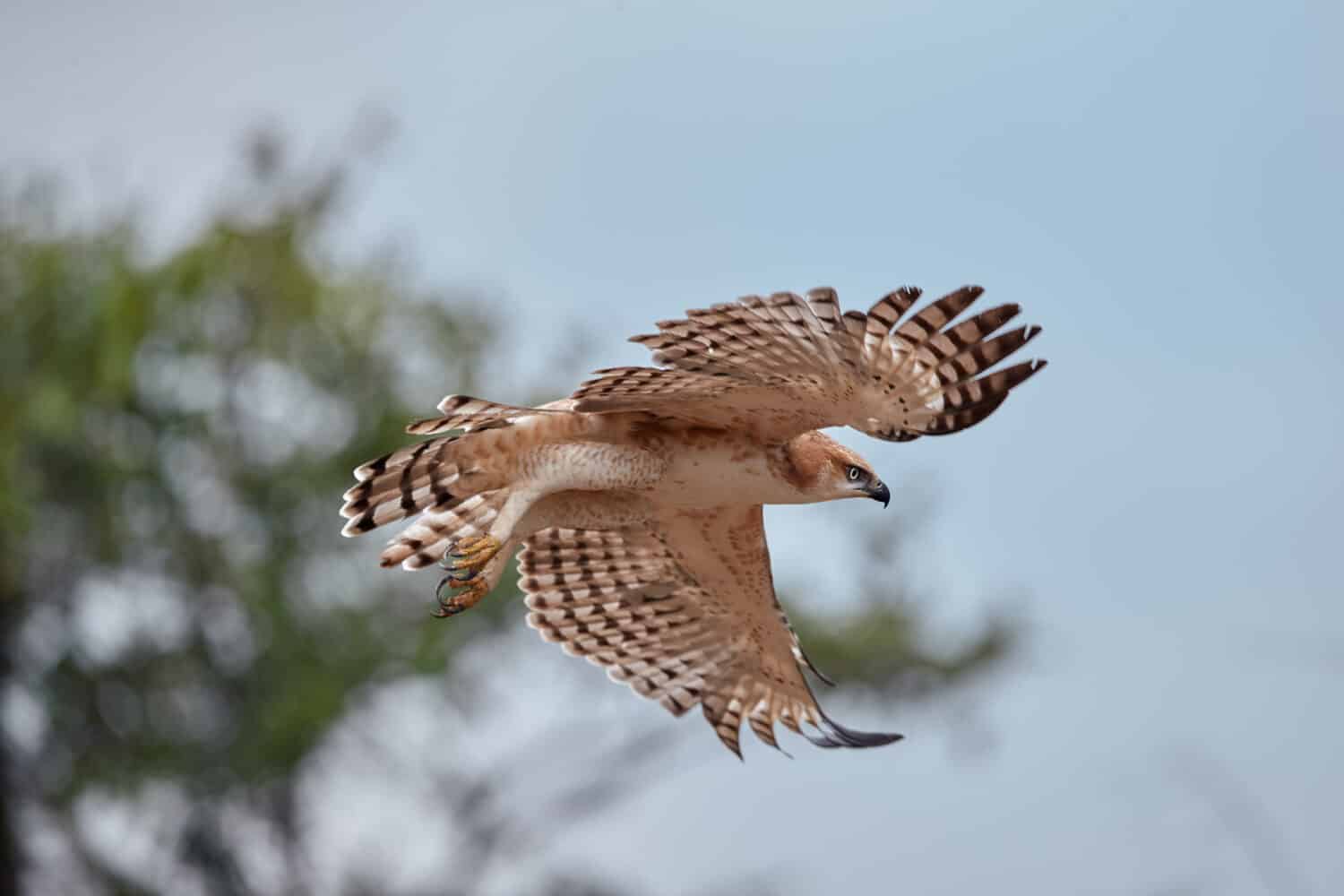
The changeable hawk-eagle is so named because of its various color morphs.
©Martin Mecnarowski/Shutterstock.com
This type of eagle was given the name “changeable” because of its variable color morphs, especially among juveniles. Its hawklike body structure – long but powerful legs, long tails, and short, broad wings – gives it greater speed and agility in the air. It uses these advantages to capture a wide variety of birds, mammals, and reptiles.
- Genus: Nisaetus
- Color: Typical morph (dark brown above; streaked underbelly); pale morph (dark brown above with paler edges; whitish underside with dark streaking); intermediate morph (similar to pale morph but with grey-brown underside); dark morph (dark chocolate brown to nearly black; brown edges; greyish tail bars)
- Length: 31 inches
- Wingspan: 4.2 to 4.5 feet
- Location: Asia
- Habitat: Forest, savanna, wetlands (inland)
- Conservation Status: Least Concern
50. Flores Hawk-Eagle (Nisaetus floris)
This type of eagle may well be the rarest eagle species in the world. The IUCN has assessed its current population in the wild at 100-240 mature individuals. Unfortunately, these numbers continue to decrease. As an inhabitant of the Lesser Sunda Islands, the species appears to be adept at crossing narrow straits to get from island to island.
- Genus: Nisaetus
- Color: Dark brown above; white underparts; white head with brown streaks; white patch on wings; dark markings on thighs
- Length: 30-31 inches
- Wingspan: —
- Location: Indonesia (Lesser Sunda Islands)
- Habitat: Forest
- Conservation Status: Critically Endangered
51. Sulawesi Hawk-Eagle (Nisaetus lanceolatus)
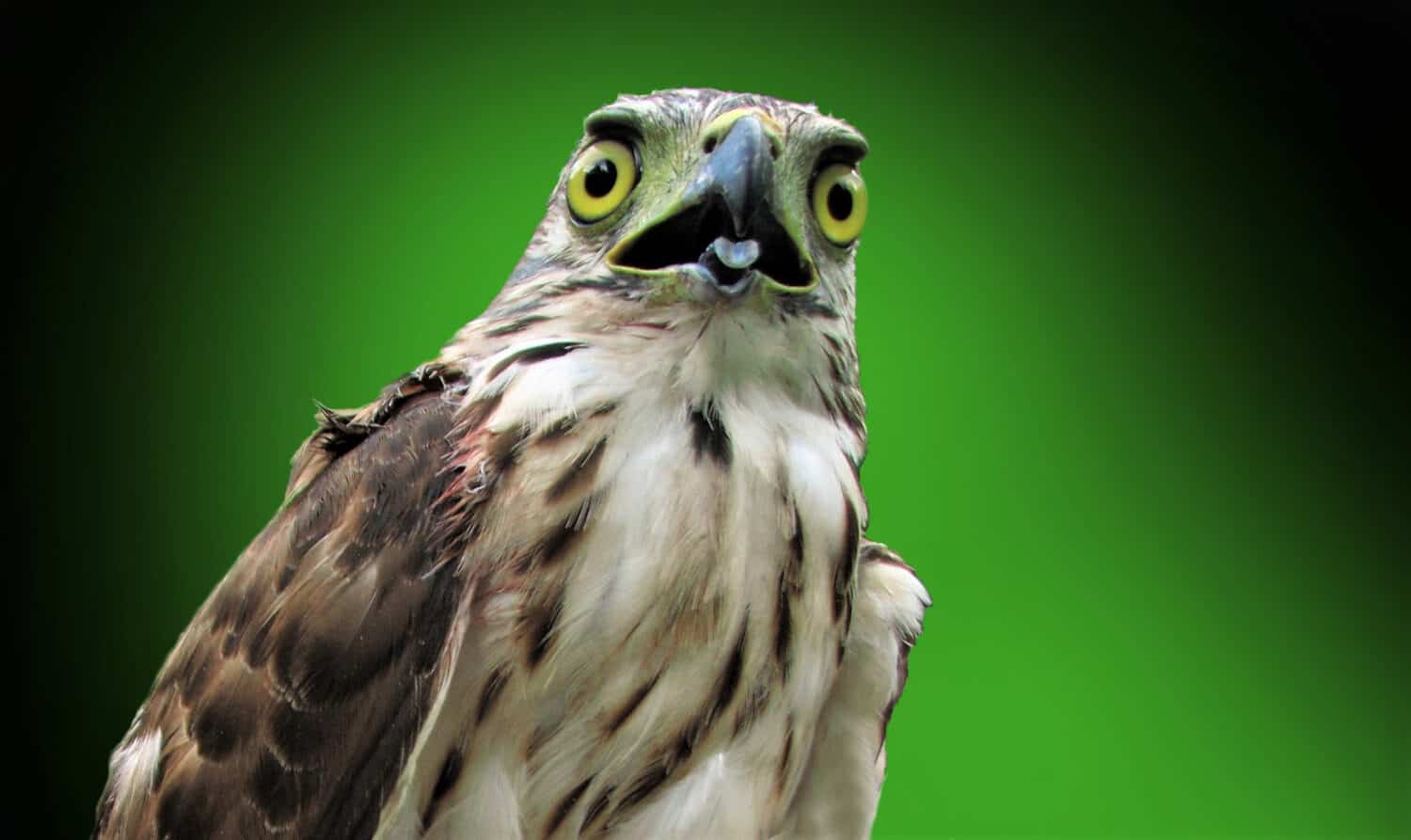
Although this species is confined to Indonesia, it is widespread throughout its range. For this reason, scientists do not currently consider it seriously endangered. Juveniles sport strikingly white heads and underparts, though these darken as they mature.
- Genus: Nisaetus
- Color: Dark brown wings; marked rufous-brown head and chest; white underbelly with black bars
- Length: 25 inches
- Wingspan: 3.6 to 4.4 feet
- Location: Indonesia
- Habitat: Forest
- Conservation Status: Least Concern
52. Wallace’s Hawk-Eagle (Nisaetus nanus)
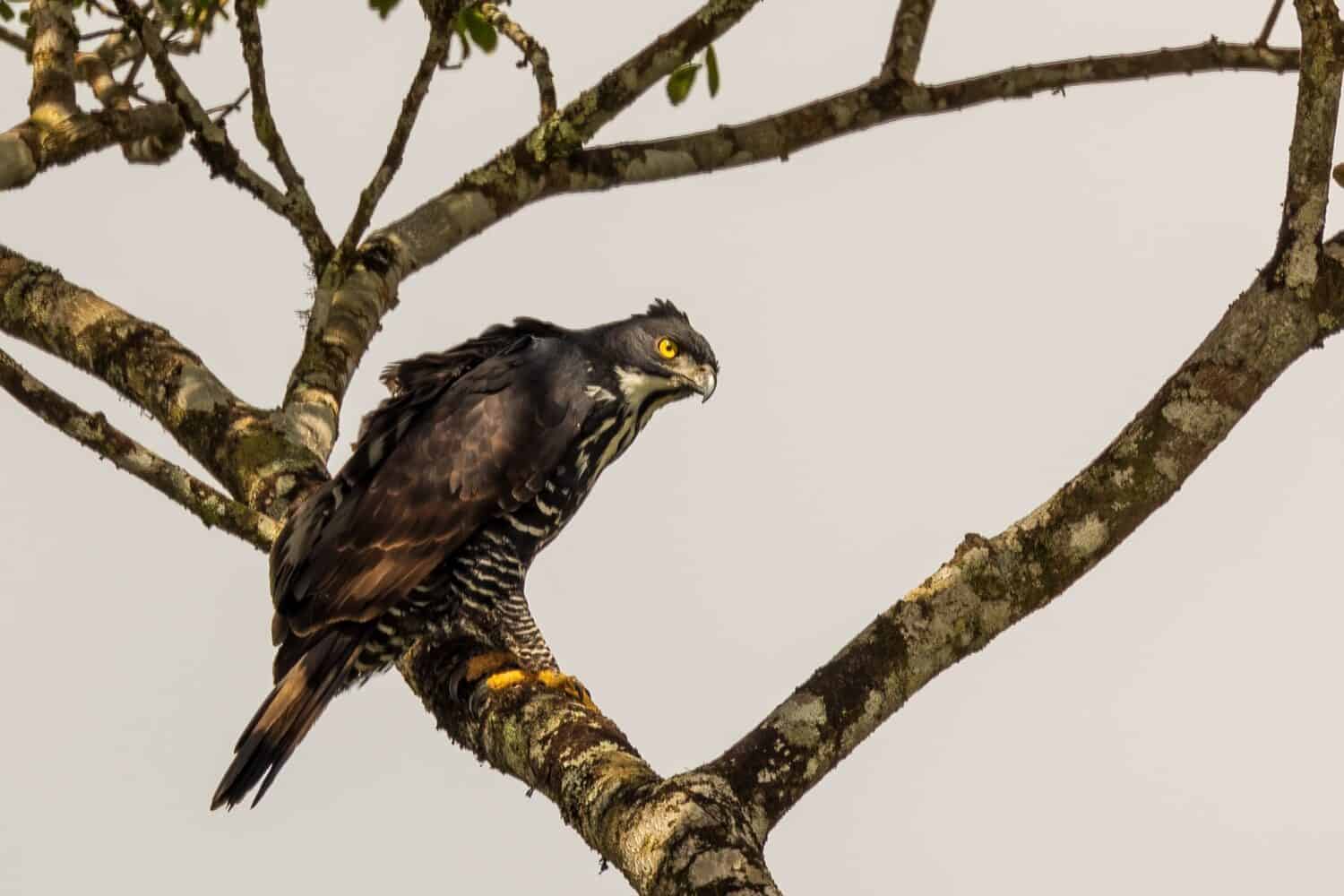
Wallace’s hawk-eagle is among the smallest eagle species in the world, about the size of a peregrine falcon. It was named after the British naturalist and biologist, Alfred Russell Wallace.
- Genus: Nisaetus
- Color: Dark brown wings; paler face; black-barred underparts; two white bands on tail
- Length: 18-23 inches
- Wingspan: 3.1 to 3.4 feet
- Location: Asia
- Habitat: Forest
- Conservation Status: Vulnerable
53. Mountain Hawk-Eagle (Nisaetus nipalensis)
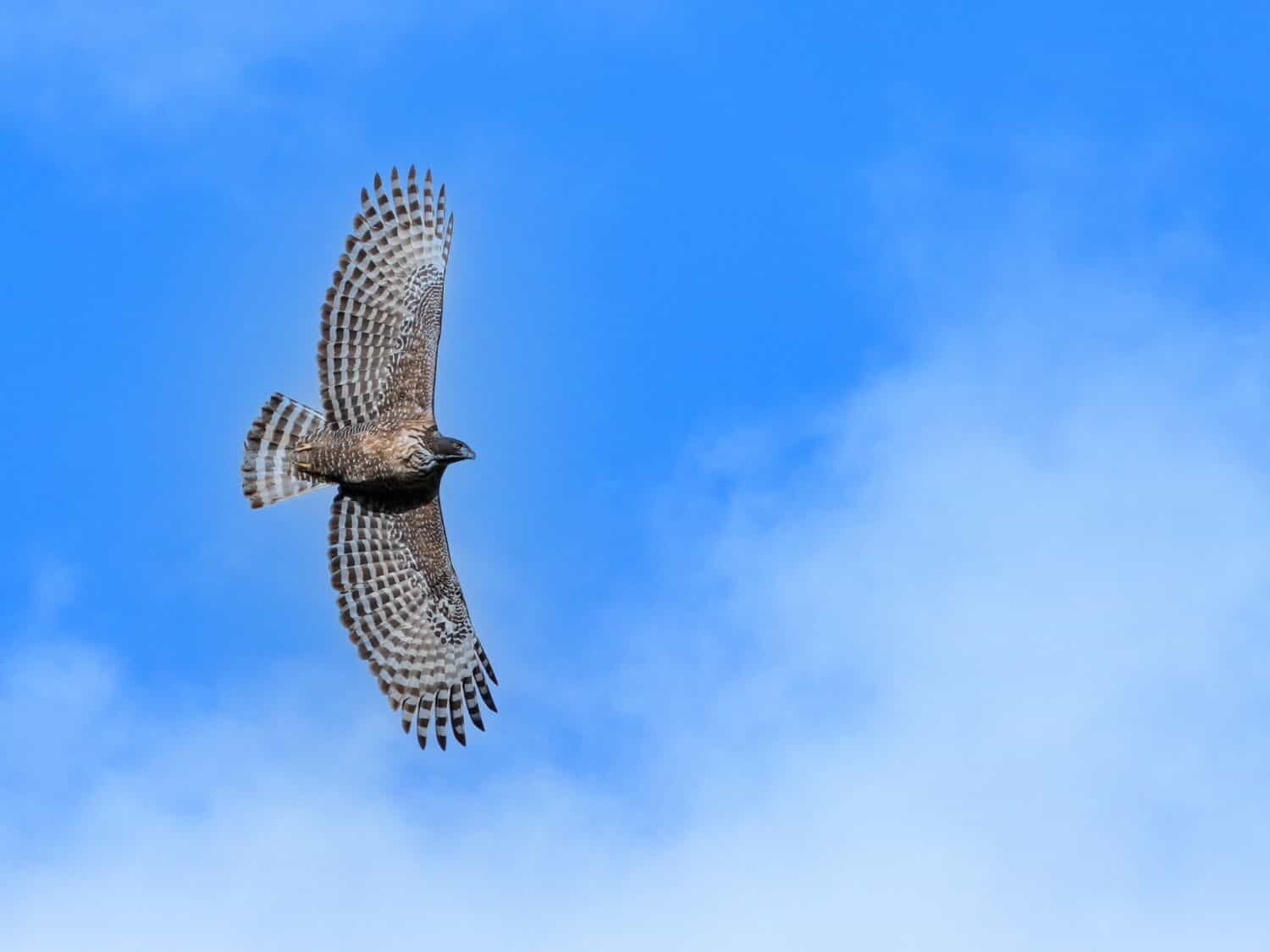
The mountain hawk-eagle has been known to target prey bigger than itself.
©scott mirror/Shutterstock.com
This type of eagle has the longest wings of all the hawk-eagles, which typically have shorter wingspans compared to open-country eagles. Much like the changeable hawk-eagle, its hawklike body structure gives it increased speed and maneuverability in the air. These ferocious predators occasionally hunt prey larger than themselves.
- Genus: Nisaetus
- Color: Dark brown with paler edges; rusty head with bold black streaks; grey-brown tail with whitish tip and black bands
- Length: 27-33 inches
- Wingspan: 4.4 to 5.7 feet
- Location: Asia
- Habitat: Forest
- Conservation Status: Near Threatened
54. North Philippine Hawk-Eagle (Nisaetus philippensis)
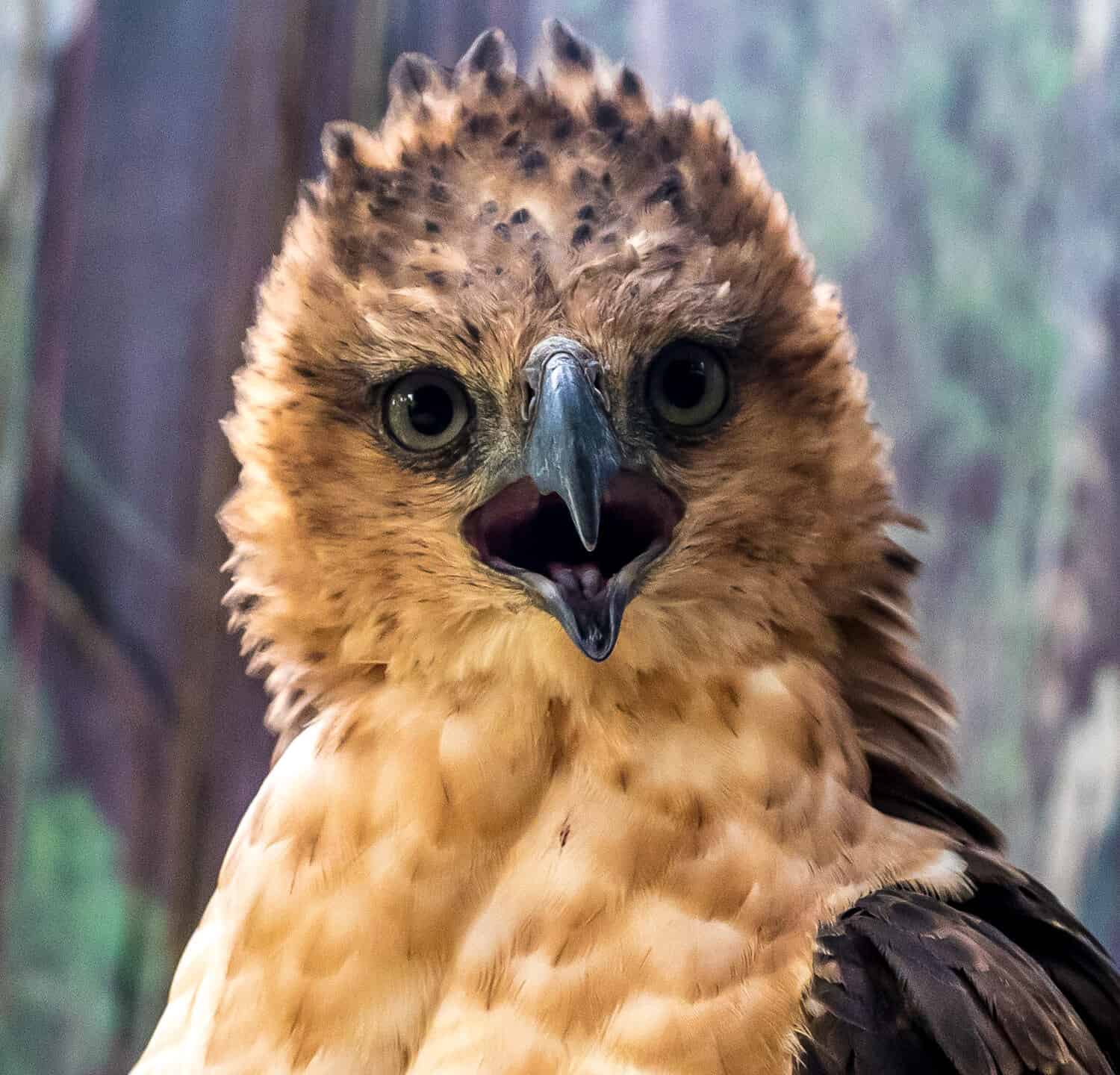
Also known as the Philippine hawk-eagle, this species is endemic to the Philippines. It sports a distinctive streaked crest on its head. Its call is a high screech, either a combined “week wik!” or a lone “week!” Due to habitat loss and trapping, its population is declining in the wild.
- Genus: Nisaetus
- Color: Dark brown above; pale brown belly; streaked head and chest; barred lower belly
- Length: 27 inches
- Wingspan: 3.4 to 4.1 feet
- Location: Philippines
- Habitat: Forest
- Conservation Status: Endangered
55. South Philippine Hawk-Eagle (Nisaetus pinskeri)

Similar to the north Philippine hawk-eagle, this type of eagle is also endemic to the Philippines. At one point, scientists believed it to be a subspecies of its north Philippine relative. They share endangered status, though the southern species is slightly more numerous. It is also known as the Pinsker’s hawk-eagle or Mindanao hawk-eagle.
- Genus: Nisaetus
- Color: Dark brown above; whitish underbelly; streaked head and chest; barred lower belly
- Length: 24 inches
- Wingspan: —
- Location: Philippines
- Habitat: Forest
- Conservation Status: Endangered
56. Philippine Eagle (Pithecophaga jefferyi)
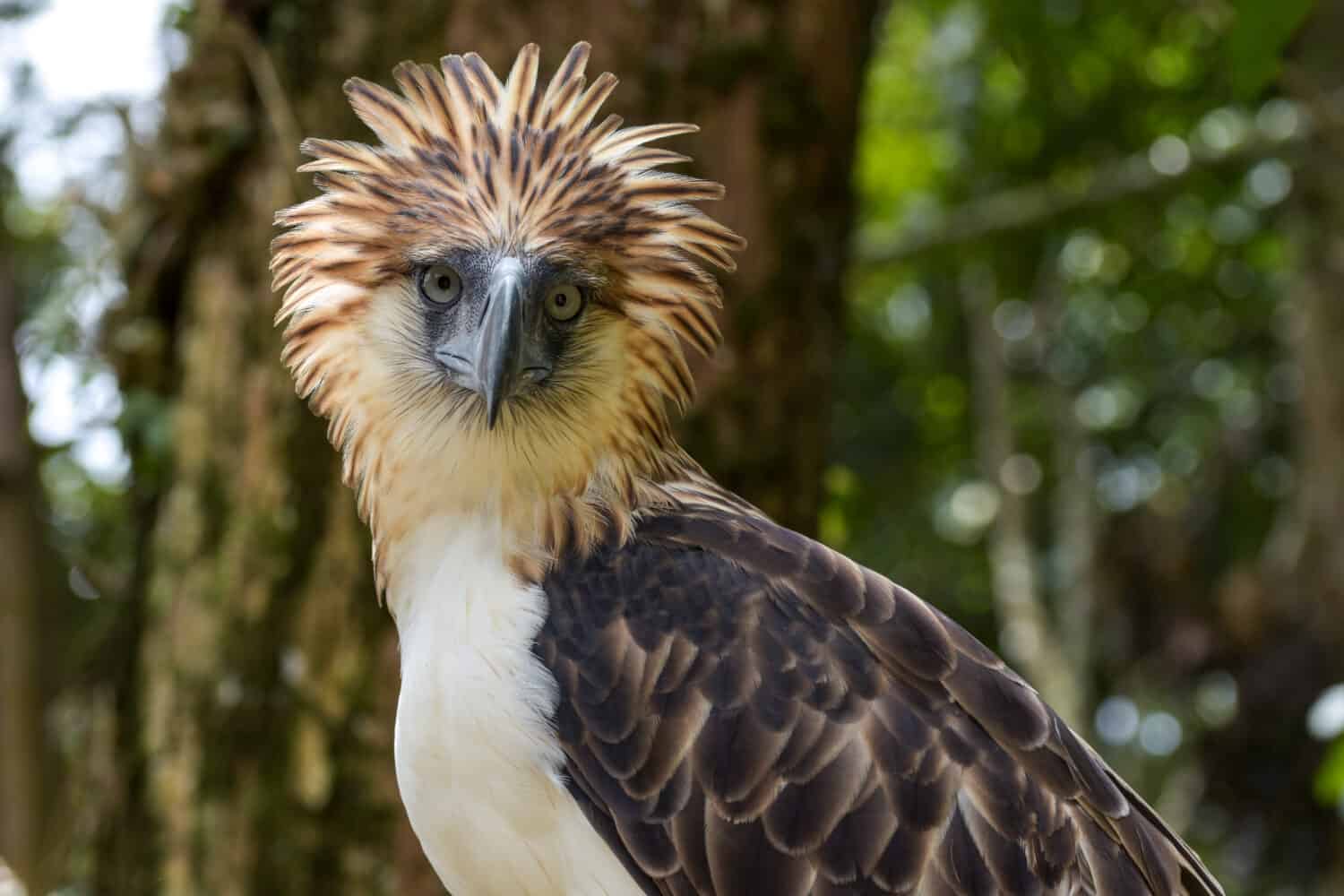
Endemic to the Philippines, this species is also known as the national bird of the Philippines, the great Philippine eagle, or the monkey-eating eagle. The last title derives from its habit of preying on the Philippine long-tailed macaque and the common long-tailed macaque. Given the species’ endangered status, anyone who kills one of these birds is subject to heavy fines and a jail term of up to 12 years. It is the largest eagle in the world by both length and wing surface area.
- Genus: Pithecophaga
- Color: Dark brown back; white underbelly and underwings; dark face; creamy-brown crown and nape
- Length: 34-40 inches (potentially as long as 41 inches)
- Wingspan: 6 to 7.2 feet
- Location: Philippines
- Habitat: Forest
- Conservation Status: Critically Endangered
57. Martial Eagle (Polemaetus bellicosus)
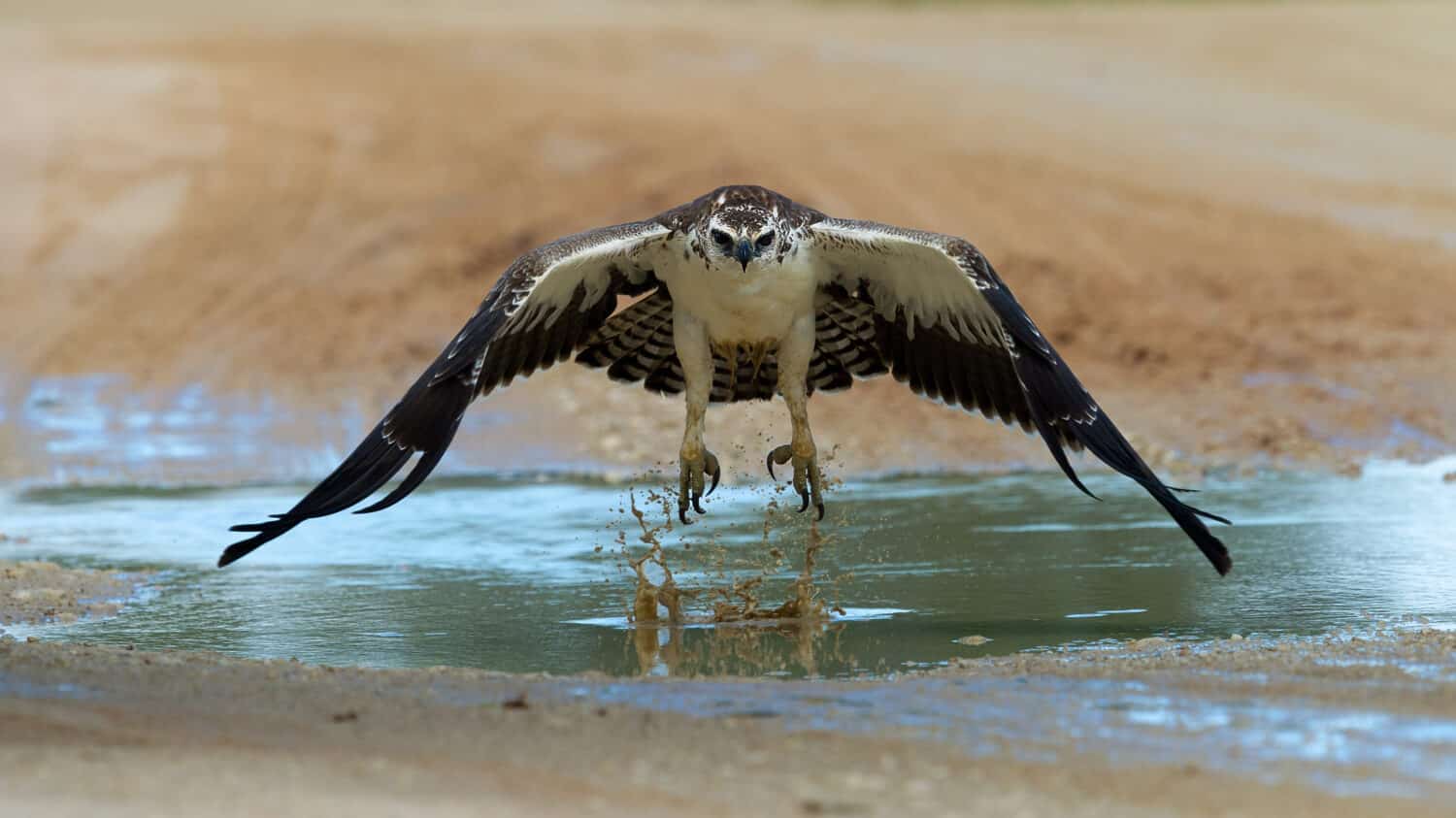
The martial eagle is a bold predator of livestock and game, leading some humans to hunt it.
©Arab/Shutterstock.com
This type of eagle is one of the longest in the world, though its unusually short tail curtails its potential. It is also one of the largest eagles in the world in terms of wingspan. A powerful and bold predator, it is remarkable for stooping on its prey from great heights. Because of its rapacious nature, humans frequently hunt it to eliminate the threat to livestock and game.
- Genus: Polemaetus
- Color: Dark brown (head, back, and upper chest) with paler edging; white underparts with blackish-brown spotting
- Length: 31-38 inches
- Wingspan: 6.2 to 7.9 feet
- Location: Africa
- Habitat: Forest, savanna, shrublands, grasslands, wetlands (inland)
- Conservation Status: Endangered
58. Crested Serpent-Eagle (Spilornis cheela)
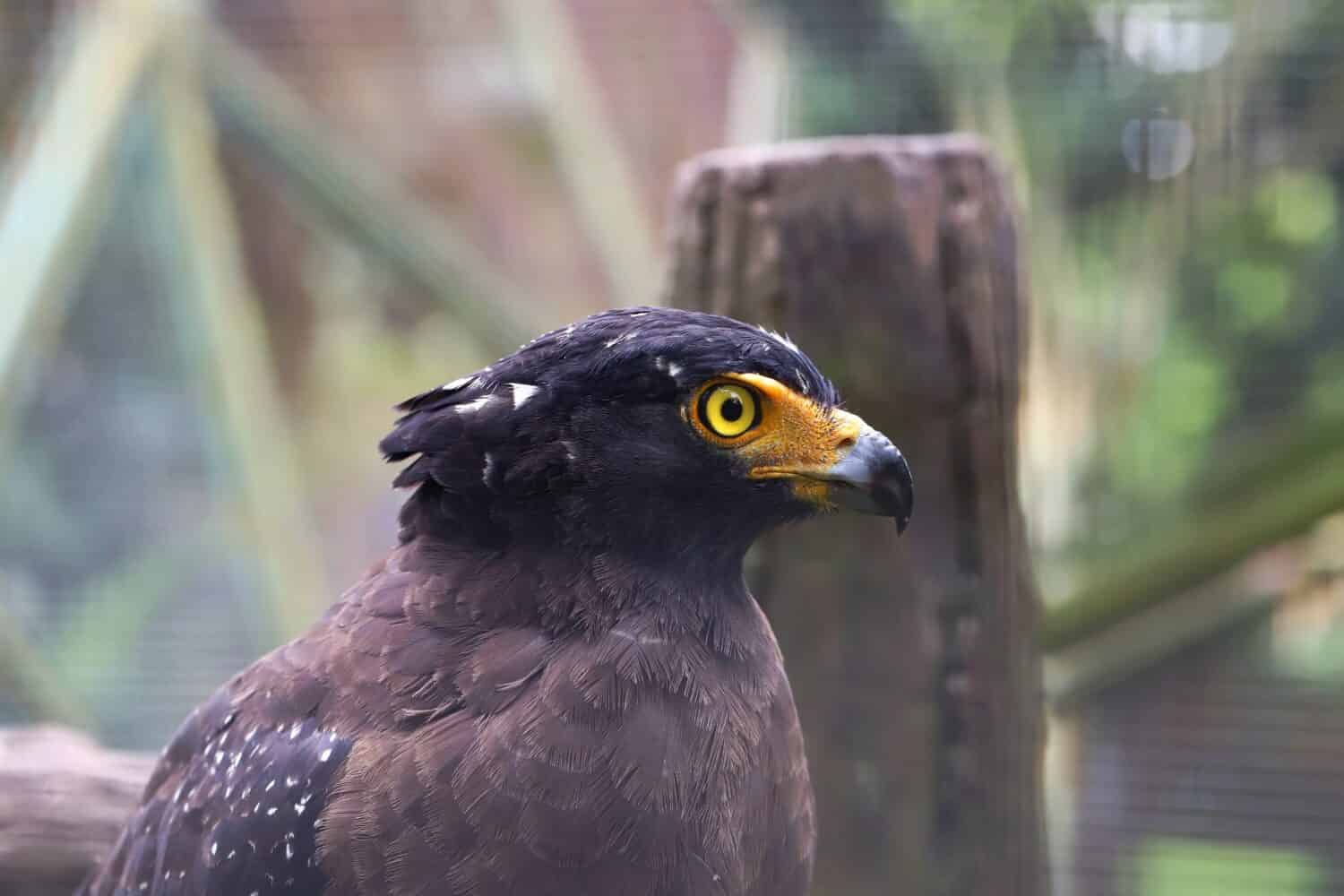
The crested serpent-eagle has a wingspan of between nearly three and 5.5 feet.
©Andi WG/Shutterstock.com
With 21 proposed subspecies, the crested serpent-eagle varies greatly in both length and wingspan. However, all subspecies have a long feathery crest, which gives them a maned appearance. This crest rises to frame the rest of the head when the bird is startled or alarmed. As its name suggests, this species prefers to hunt reptiles, especially snakes and lizards.
- Genus: Spilornis
- Color: Dark brown; underside spotted with white and yellowish-brown
- Length: 16-30 inches
- Wingspan: 2.9 to 5.5 feet
- Location: Asia
- Habitat: Forest, savanna, marine (neritic)
- Conservation Status: Least Concern
59. Andaman Serpent-Eagle (Spilornis elgini)
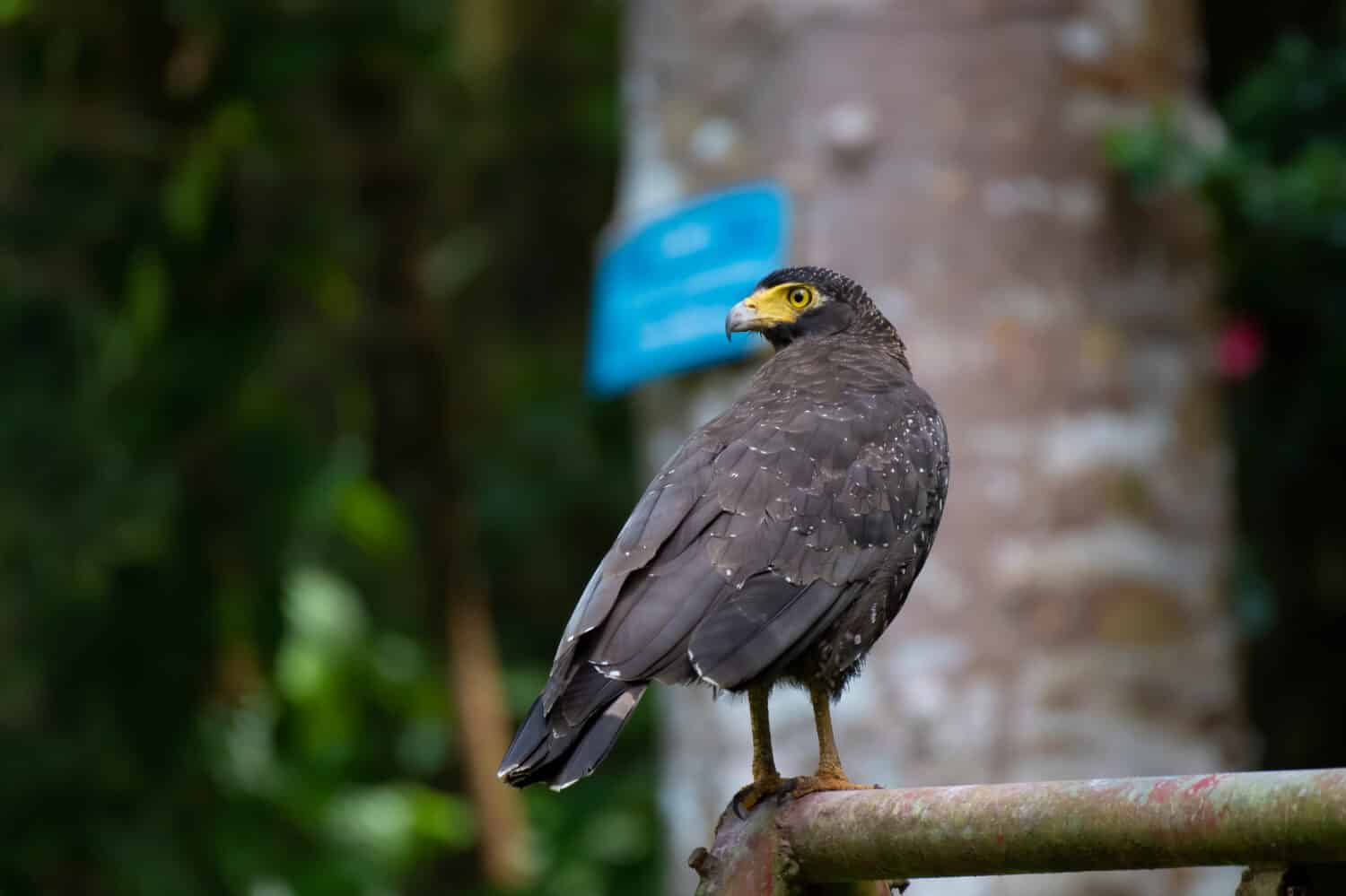
The Andaman serpent-eagle has thick scales on its legs and feet to protect it from snakebites.
©mihirjoshi/Shutterstock.com
The Andaman serpent-eagle is endemic to the Andaman Islands of India. Although this species hunts snakes, it also preys on other reptiles as well as birds, frogs, and rats. Thick scales on its legs and feet protect it from the bites of venomous snakes. During breeding season, it engages in spectacular aerial courtship displays such as diving and talon locking. Alternate names for this species include the Andaman dark serpent-eagle and the dark serpent-eagle.
- Genus: Spilornis
- Color: Dark brown with white spots on chest and wings; white and black bands on underside of wings; black bands on tail
- Length: 21 inches
- Wingspan: 3.8 to 4 feet
- Location: India
- Habitat: Forest
- Conservation Status: Vulnerable
60. Philippine Serpent-Eagle (Spilornis holospilus)

As its name suggests, this type of eagle is one of several endemic to the Philippines. It occurs on the majority of the major islands with the exception of Palawan. In terms of its diet, it targets reptiles and amphibians as well as other live prey. The prominent spotting on its underside and underwings helps distinguish it from other serpent-eagles.
- Genus: Spilornis
- Color: Dark brown with white spots on crown and upperparts; grey cheeks; rufous-brown below with white spots
- Length: 25 inches
- Wingspan: —
- Location: Philippines
- Habitat: Forest
- Conservation Status: Least Concern
61. Kinabalu Serpent-Eagle (Spilornis kinabaluensis)

This type of eagle derives its name from Mount Kinabalu, the highest mountain in Borneo and Malaysia. Due to its affinity for high altitudes – as high as 13,500 feet – it is also known as the mountain serpent-eagle. Although logging and agriculture have resulted in some habitat loss, the high altitude of much of its range largely protects it from such destructive influences.
- Genus: Spilornis
- Color: Dark overall; dark head; chestnut underparts; white wing and tail bands
- Length: 23 inches
- Wingspan: 3.9 to 4.2 feet
- Location: Asia
- Habitat: Forest
- Conservation Status: Near Threatened
62. Great Nicobar Serpent-Eagle (Spilornis klossi)
One of the smallest eagles in the world, this species measures less than a foot and a half in length. It is endemic to Great Nicobar Island in India. Despite its resemblance to the crested serpent-eagle, the lack of markings on its underparts helps distinguish it.
- Genus: Spilornis
- Color: Pale brown; pale underparts
- Length: 15-17 inches
- Wingspan: 2.8 to 3.1 feet
- Location: India (Great Nicobar Island)
- Habitat: Forest
- Conservation Status: Near Threatened
63. Black-and-Chestnut Eagle (Spizaetus isidori)
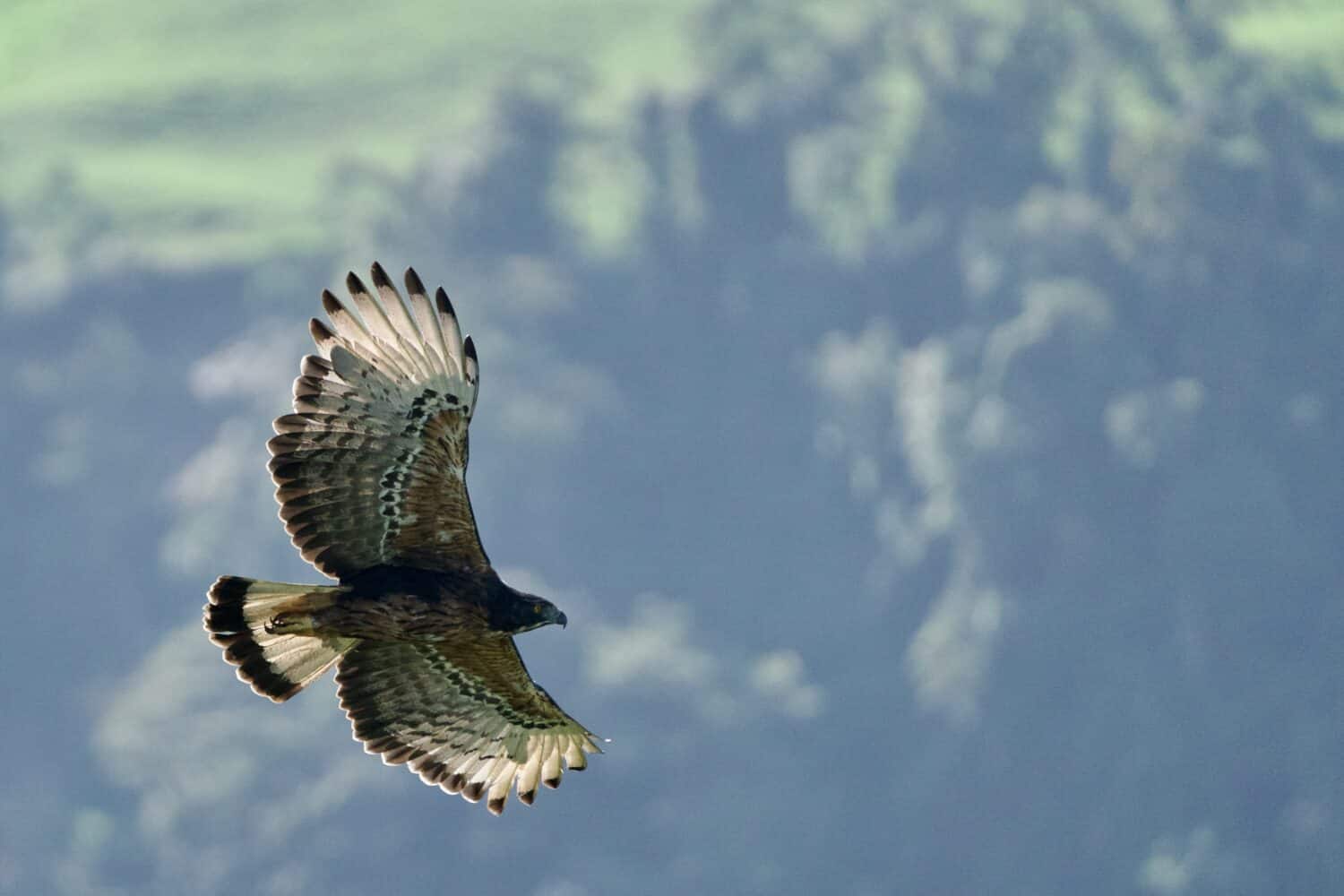
The black-and-chestnut eagle is the largest member of its genus with a wingspan of up to nearly six feet.
©jeremaixs/Shutterstock.com
This type of eagle is the largest member of its genus with a maximum wingspan approaching six feet. Its name reflects its glossy black upperparts and chestnut underparts. Due to its habit of preying on domestic fowl, it is often subject to persecution from human hunters.
- Genus: Spizaetus
- Color: Glossy black (head and back); chestnut on underside; greyish tail with thick black band
- Length: 24-31 inches
- Wingspan: 4.8 to 5.9 feet
- Location: South America
- Habitat: Forest
- Conservation Status: Endangered
64. Black-and-White Hawk-Eagle (Spizaetus melanoleucus)
The stunning dichotomous coloration of this type of eagle is easily recognizable within its range. It preys on a variety of animals including birds, reptiles, toads, and mammals. It typically soars overhead while on the hunt, swooping down once it spots its prey.
- Genus: Spizaetus
- Color: Blackish upperparts; black mask and crest; white underparts
- Length: 20-24 inches
- Wingspan: —
- Location: North America, South America
- Habitat: Forest, savanna
- Conservation Status: Least Concern
65. Ornate Hawk-Eagle (Spizaetus ornatus)
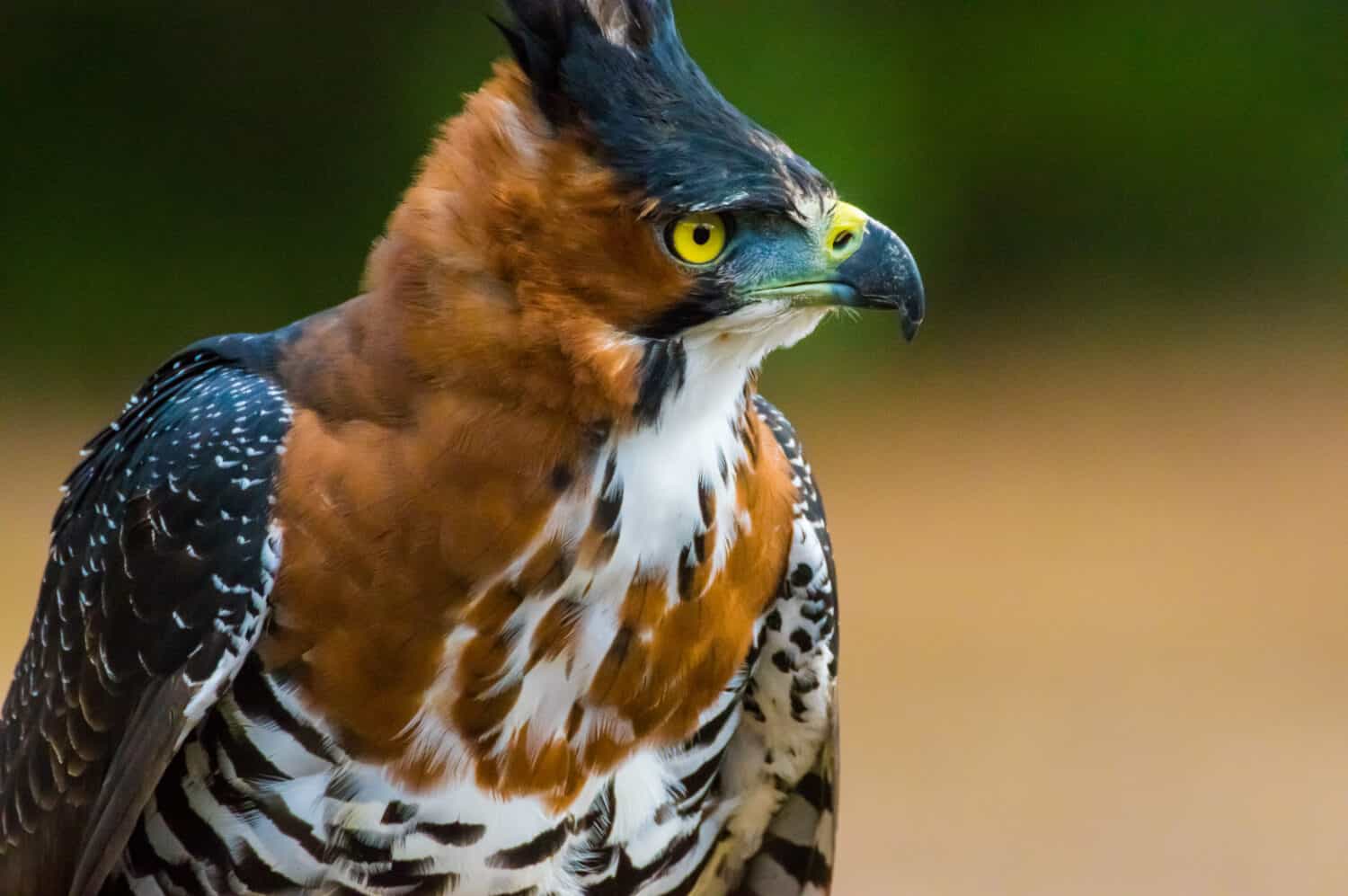
The ornate hawk-eagle lives up to its name with its striking combination of blackish-brown barring, rufous-colored nape, and black-barred whitish underside. This mighty predator primarily hunts small-to-medium mammals and medium-to-large birds, though it occasionally targets reptiles.
- Genus: Spizaetus
- Color: Blackish to dark brown barring; rufous nape; whitish underside with black barring
- Length: 22-27 inches
- Wingspan: 3.8 to 4.7 feet
- Location: North America, South America
- Habitat: Forest, savanna
- Conservation Status: Near Threatened
66. Black Hawk-Eagle (Spizaetus tyrannus)

This species is also known as the tyrant hawk-eagle, a reference to the name tyrannus. Despite its relatively small size, it often pursues sizeable prey like monkeys, opossums, and iguanas. Its closest relative is the ornate hawk-eagle.
- Genus: Spizaetus
- Color: Black with varying patterns and white speckles; grey bars on tail
- Length: 23-28 inches
- Wingspan: 3.8 to 4.9 feet
- Location: North America, South America
- Habitat: Forest, wetlands (inland)
- Conservation Status: Least Concern
67. Crowned Eagle (Stephanoaetus coronatus)
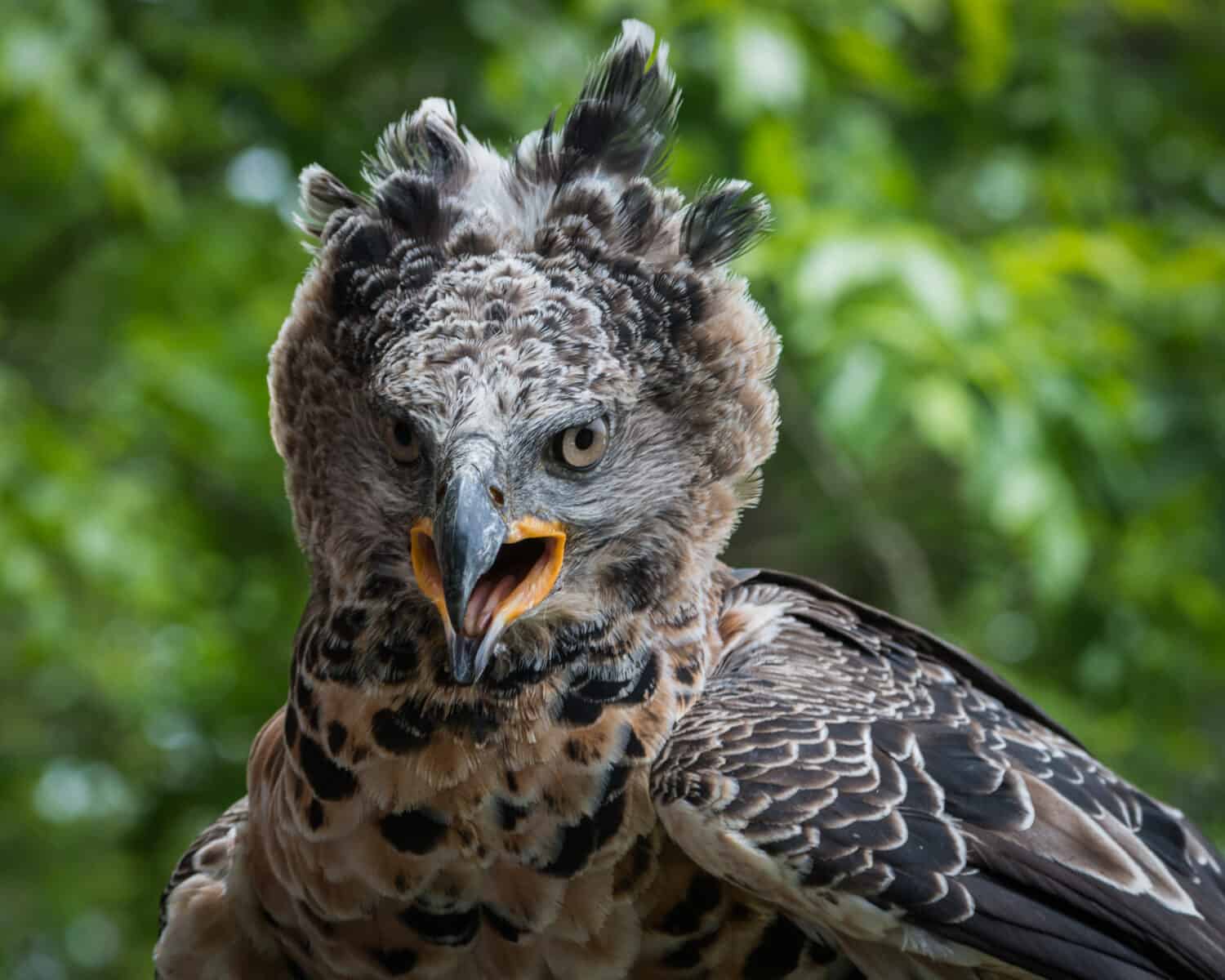
The crowned eagle has impressive talons that it may use to crush the skulls of its prey.
©Jordan Confino/Shutterstock.com
Not to be confused with the crowned solitary eagle, this immense species belongs to the genus Stephanoaetus. It is also known as the African crowned eagle and crowned hawk-eagle. With its incredibly strong legs and talons, it is possible that it kills its prey by crushing its skull.
- Genus: Stephanoaetus
- Color: Blackish brown-grey upperparts with variable blue tinge; dark crown; brown throat; white breast and belly with dark bars and markings; black tail with brownish-grey bands
- Length: 31-39 inches
- Wingspan: 5 to 6.2 feet
- Location: Africa
- Habitat: Forest, savanna, wetlands (inland)
- Conservation Status: Near Threatened
68. Bateleur (Terathopius ecaudatus)

The bateleur is a visually striking bird whose French name means “street performer.”
©Carrie Ogle/Shutterstock.com
The bateleur is one of the most striking eagles in the world with its contrasting black, grey, white, and red coloration. Its name – French for “street performer” – reflects its flamboyant appearance. Its wing motions during takeoff are unusually quick and shallow for its significant size.
- Genus: Terathopius
- Color: Black with chestnut on mantle; grey patches on wings; white greater coverts; bright red cere and feet
- Length: 22-28 inches
- Wingspan: 5.5 to 6.2 feet
- Location: Africa
- Habitat: Forest, savanna, shrubland, grassland
- Conservation Status: Endangered
Summary of Every Type of Eagle
*These tables are sorted alphabetically by genus and scientific name.
Genus Aquila
| Common Name | Scientific Name | Location | Defining Characteristics | Conservation Status |
|---|---|---|---|---|
| Spanish Imperial Eagle | Aquila adalberti | Europe, Africa | Shy of humans Prefers rabbits as prey | Vulnerable (increasing) |
| Cassin’s Hawk-Eagle | Aquila africana | Africa | Feathered legs Smallest member of Aquila | Least Concern (decreasing) |
| Wedge-Tailed Eagle | Aquila audax | Asia, Oceania | Largest bird of prey in Australia Wedge-shaped tail | Least Concern (increasing) |
| Golden Eagle | Aquila chrysaetos | Africa, Asia, Europe, North America, South America | Golden-brown plumage Large wingspan | Least Concern (stable) |
| Bonelli’s Eagle | Aquila fasciata | Africa, Asia, Europe | Aerial Feathered legs | Least Concern (decreasing) |
| Gurney’s Eagle | Aquila gurneyi | Asia, Oceania | Holds wings level while gliding | Near Threatened (decreasing) |
| Eastern Imperial Eagle | Aquila heliaca | Africa, Asia, Europe | Bolder than average around humans Projecting neck and large heads/bills | Vulnerable (decreasing) |
| Steppe Eagle | Aquila nipalensis | Africa, Asia, Europe | Breeds on steppes Bulky body | Endangered (decreasing) |
| Tawny Eagle | Aquila rapax | Africa, Asia | Scruffy Aquiline silhouette Scavenger | Vulnerable (decreasing) |
| African Hawk-Eagle | Aquila spilogaster | Africa | Powerful body, large feet Builds large stick nests | Least Concern (decreasing) |
| Verreaux’s Eagle | Aquila verreauxii | Africa | Black-and-white plumage Sixth longest eagle in the world | Least Concern (stable) |
Genus Buteogallus
| Common Name | Scientific Name | Location | Defining Characteristics | Conservation Status |
|---|---|---|---|---|
| Crowned Solitary Eagle | Buteogallus coronatus | South America | Dark grey crest (“crown”) on head Shrill and powerful call | Endangered (decreasing) |
| Black Solitary Eagle | Buteogallus solitarius | North America, South America | Prefers mountainous or hilly forests Potentially preys on snakes and deer fawns | Near Threatened (decreasing) |
Genus Circaetus
| Common Name | Scientific Name | Location | Defining Characteristics | Conservation Status |
|---|---|---|---|---|
| Beaudouin’s Snake Eagle | Circaetus beaudouini | Africa | Prefers to sit and wait for its prey | Vulnerable (decreasing) |
| Western Banded Snake Eagle | Circaetus cinerascens | Africa | Solitary and elusive Preys mainly on snakes | Least Concern (decreasing) |
| Brown Snake Eagle | Circaetus cinereus | Africa | Displays a purple sheen in certain lights Hunts both harmless and venomous snakes | Least Concern (decreasing) |
| Southern Banded Snake Eagle | Circaetus fasciolatus | Africa | Elusive Primarily hunts snakes | Near Threatened (decreasing) |
| Short-Toed Snake Eagle | Circaetus gallicus | Africa, Asia, Europe | Larger and more aerial than most snake eagles | Least Concern (stable) |
| Black-Chested Snake Eagle | Circaetus pectoralis | Africa | Both solitary and communal Hunts venomous snakes | Least Concern (stable) |
Genus Clanga
| Common Name | Scientific Name | Location | Defining Characteristics | Conservation Status |
|---|---|---|---|---|
| Greater Spotted Eagle | Clanga clanga | Africa, Asia, Europe | Aerial hunter Prefers wetter habitats than most booted eagles | Vulnerable (decreasing) |
| Indian Spotted Eagle | Clanga hastata | Asia | Widest mouth of any spotted eagle Relatively approachable | Vulnerable (decreasing) |
| Lesser Spotted Eagle | Clanga pomarina | Africa, Asia, Europe | White V on rump Yipping call Occasionally mates with greater spotted eagle | Least Concern (stable) |
Genus Dryotriorchis
| Common Name | Scientific Name | Location | Defining Characteristics | Conservation Status |
|---|---|---|---|---|
| Congo Serpent-Eagle | Dryotriorchis spectabilis | Africa | Only member of its genus Adept at hunting in understory of African rainforest | Least Concern (decreasing) |
Genus Eutriorchis
| Common Name | Scientific Name | Location | Defining Characteristics | Conservation Status |
|---|---|---|---|---|
| Madagascar Serpent-Eagle | Eutriorchis astur | Africa (Madagascar) | Endemic to Madagascar Thought to be extinct at one point | Endangered (decreasing) |
Genus Geranoaetus
| Common Name | Scientific Name | Location | Defining Characteristics | Conservation Status |
|---|---|---|---|---|
| Black-Chested Buzzard-Eagle | Geranoaetus melanoleucus | South America | Powerful build, impressive wingspan Black chest One of its cries sounds like human laughter | Least Concern (stable) |
Genus Haliaeetus
| Common Name | Scientific Name | Location | Defining Characteristics | Conservation Status |
|---|---|---|---|---|
| White-Tailed Sea-Eagle | Haliaeetus albicilla | Asia, Europe | Largest eagle found in Europe Possibly greatest wingspan of any eagle White tail | Least Concern (increasing) |
| Bald Eagle | Haliaeetus Ieucocephaus | Asia, Europe, North America, South America | National bird of the US White head Fast and agile | Least Concern (increasing) |
| White-Bellied Sea-Eagle | Haliaeetus leucogaster | Asia, Oceania | White breast and belly Honking cry Monogamous | Least Concern (decreasing) |
| Pallas’s Fish-Eagle | Haliaeetus leucoryphus | Asia, Europe | Widely varied diet Can fly with loads heavier than itself | Endangered (decreasing) |
| Steller’s Sea-Eagle | Haliaeetus pelagicus | Asia, North America | Among the three heaviest eagles in the world Barking cry Rare dark morph | Vulnerable (decreasing) |
| Sanford’s Sea-Eagle | Haliaeetus sanfordi | Oceania | Only large predator in Solomon Islands archipelago | Vulnerable (decreasing) |
| African Fish-Eagle | Haliaeetus vocifer | Africa | Endemic to sub-Saharan Africa Resembles bald eagle Evocative cry | Least Concern (stable) |
| Madagascar Fish-Eagle | Haliaeetus vociferoides | Africa (Madagascar) | Closely related to the African fish-eagle Critically endangered | Critically Endangered (decreasing) |
Genus Harpia
| Common Name | Scientific Name | Location | Defining Characteristics | Conservation Status |
|---|---|---|---|---|
| Harpy Eagle | Harpia harpyja | North America, South America | One of three largest eagles Largest talons of any living eagles Carries up to half its body weight | Vulnerable (decreasing) |
Genus Harpyopsis
| Common Name | Scientific Name | Location | Defining Characteristics | Conservation Status |
|---|---|---|---|---|
| Papuan Eagle | Harpyopsis novaeguineae | Indonesia – Papua, Papua New Guinea | Endemic to New Guinea Unusual physical proportions | Vulnerable (decreasing) |
Genus Hieraaetus
| Common Name | Scientific Name | Location | Defining Characteristics | Conservation Status |
|---|---|---|---|---|
| Ayres’s Hawk-Eagle | Hieraaetus ayresii | Africa | Almost exclusively hunts other birds | Least Concern (decreasing) |
| Little Eagle | Hieraaetus morphnoides | Australia | Endemic to Australia Very small in size | Least Concern (stable) |
| Booted Eagle | Hieraaetus pennatus | Africa, Asia, Europe | Both light form and dark form exist | Least Concern (stable) |
| Wahlberg’s Eagle | Hieraaetus wahlbergi | Africa | Stunning aerial courtship displays Ability to fly quickly over long distances | Least Concern (stable) |
| Pygmy Eagle | Hieraaetus weiskei | Indonesia, Papua New Guinea | One of the smallest eagle species Quick and agile in the air | Least Concern (decreasing) |
Genus Icthyophaga
| Common Name | Scientific Name | Location | Defining Characteristics | Conservation Status |
|---|---|---|---|---|
| Lesser Fish-Eagle | Icthyophaga humilis | Asia | Uses several personal perches to view its prey in the water | Near Threatened (decreasing) |
| Grey-Headed Fish-Eagle | Icthyophaga ichthyaetus | Asia | Piscivorous Likes hanging around irrigation tanks in Sri Lanka | Near Threatened (decreasing) |
Genus Ictinaetus
| Common Name | Scientific Name | Location | Defining Characteristics | Conservation Status |
|---|---|---|---|---|
| Black Eagle | Ictinaetus malaiensis | Asia | Slender form, leisurely and prolonged flight Affinity for eating eggs | Least Concern (decreasing) |
Genus Lophaetus
| Common Name | Scientific Name | Location | Defining Characteristics | Conservation Status |
|---|---|---|---|---|
| Long-Crested Eagle | Lophaetus occipitalis | Africa | Long feathers form a crest on head Primarily eats rodents | Least Concern (increasing) |
Genus Lophotriorchis
| Common Name | Scientific Name | Location | Defining Characteristics | Conservation Status |
|---|---|---|---|---|
| Rufous-Bellied Eagle | Lophotriorchis kienerii | Asia | Physically striking (black, white, and chestnut) Most often observed soaring | Near Threatened (decreasing) |
Genus Morphnus
| Common Name | Scientific Name | Location | Defining Characteristics | Conservation Status |
|---|---|---|---|---|
| Crested Eagle | Morphnus guianensis | North America, South America | Distinctive feathery crest on head Hunts small monkeys | Near Threatened (decreasing) |
Genus Nisaetus
| Common Name | Scientific Name | Location | Defining Characteristics | Conservation Status |
|---|---|---|---|---|
| Blyth’s Hawk-Eagle | Nisaetus alboniger | Asia | Striking feathery crest on head Spotted and barred breast and underbelly | Least Concern (decreasing) |
| Javan Hawk-Eagle | Nisaetus bartelsi | Indonesia (Java) | Striking feathery head crest One of the rarest raptors in the world | Endangered (decreasing) |
| Changeable Hawk-Eagle | Nisaetus cirrhatus | Asia | Various color morphs Hawklike body structure | Least Concern (decreasing) |
| Flores Hawk-Eagle | Nisaetus floris | Indonesia (Lesser Sunda Islands) | Possibly the rarest eagle in the world Crosses narrow straits to get from island to island | Critically Endangered (decreasing) |
| Sulawesi Hawk-Eagle | Nisaetus lanceolatus | Indonesia | Endemic to Indonesia Juveniles are notable for striking white heads and underparts | Least Concern (decreasing) |
| Wallace’s Hawk-Eagle | Nisaetus nanus | Asia | Among the smallest eagles in the world | Vulnerable (decreasing) |
| Mountain Hawk-Eagle | Nisaetus nipalensis | Asia | Longest wings of all hawk-eagles Possesses great speed and agility Occasionally hunts prey larger than itself | Near Threatened (decreasing) |
| North Philippine Hawk-Eagle | Nisaetus philippensis | Philippines | Endemic to Philippines Streaked crest on head High, screeching call | Endangered (decreasing) |
| South Philippine Hawk-Eagle | Nisaetus pinskeri | Philippines | Similar to the north Philippine hawk-eagle | Endangered (decreasing) |
Genus Pithecophaga
| Common Name | Scientific Name | Location | Defining Characteristics | Conservation Status |
|---|---|---|---|---|
| Philippine Eagle | Pithecophaga jefferyi | Philippines | Largest eagle in the world by length and wing surface area Protected by Philippine law | Critically Endangered (decreasing) |
Genus Polemaetus
| Common Name | Scientific Name | Location | Defining Characteristics | Conservation Status |
|---|---|---|---|---|
| Martial Eagle | Polemaetus bellicosus | Africa | Among the longest eagles in the world One of the largest wingspans of any eagle | Endangered (decreasing) |
Genus Spilornis
| Common Name | Scientific Name | Location | Defining Characteristics | Conservation Status |
|---|---|---|---|---|
| Crested Serpent-Eagle | Spilornis cheela | Asia | Long feathery crests (rises when alarmed) Hunts reptiles, especially snakes and lizards | Least Concern (stable) |
| Andaman Serpent-Eagle | Spilornis elgini | India (Andaman Islands) | Thick scales on legs and feet protect it from snake bites Elaborate aerial courtship displays | Vulnerable (decreasing) |
| Philippine Serpent-Eagle | Spilornis holospilus | Philippines | Endemic to Philippines Prominent spots on underparts | Least Concern (decreasing) |
| Kinabalu Serpent-Eagle | Spilornis kinabaluensis | Asia | Affinity for high altitudes Named after Mount Kinabalu | Near Threatened (decreasing) |
| Great Nicobar Serpent-Eagle | Spilornis klossi | India (Great Nicobar Island) | One of the smallest extant eagles Endemic to Great Nicobar Island | Near Threatened (decreasing) |
Genus Spizaetus
| Common Name | Scientific Name | Location | Defining Characteristics | Conservation Status |
|---|---|---|---|---|
| Black-and-Chestnut Eagle | Spizaetus isidori | South America | Black and chestnut in color Largest member of its genus | Endangered (decreasing) |
| Black-and-White Hawk-Eagle | Spizaetus melanoleucus | North America, South America | Stunning dichotomous coloration (black and white) | Least Concern (decreasing) |
| Ornate Hawk-Eagle | Spizaetus ornatus | North America, South America | Ornate coloration Powerful predator | Near Threatened (decreasing) |
| Black Hawk-Eagle | Spizaetus tyrannus | North America, South America | Called the tyrant hawk-eagle Hunts larger prey | Least Concern (decreasing) |
Genus Stephanoaetus
| Common Name | Scientific Name | Location | Defining Characteristics | Conservation Status |
|---|---|---|---|---|
| Crowned Eagle | Stephanoaetus coronatus | Africa | Possibly kills by crushing the skull One of the largest eagle species | Near Threatened (decreasing) |
Genus
| Common Name | Scientific Name | Location | Defining Characteristics | Conservation Status |
|---|---|---|---|---|
| Bateleur | Terathopius ecaudatus | Africa | Striking coloration Name is French for “street performer” | Endangered (decreasing) |
The photo featured at the top of this post is © iStock.com/Kandfoto
Thank you for reading! Have some feedback for us? Contact the AZ Animals editorial team.






